Anthony Kang: Fate, Funky Music and the Badlands (Part 2)

In the second and final part of our feature on three-time Asian Tour winner Anthony Kang, the American talks about his famous victory at the Maybank Malaysian Open, swing fundamentals and his transition into TV land.

KUALA LUMPUR, MALAYSIA – FEBRUARY 15: Anthony Kang of USA poses with the trophy after winning the Final round of the 2009 Maybank Malaysian Open at Saujana Golf and Country Club on February 15, 2009 in Kuala Lumpur, Malaysia. (Photo by Ian Walton/Getty Images)
While Anthony Kang always looks back on his victory at Casino Filipino Philippine Open in 1999 as one of the great highlights of his career – because it was his maiden win – his triumph in Malaysia’s National Open 10 years later carries as much significance to him, and perhaps even more.
It is the manner of that win, which came down to a nail-biting finish, which is so important to him.
“At the Maybank Malaysian Open having a chance to hit my second shot on the par-five final hole of the tournament, the 72nd hole, and knowing if I pulled the shot off I was going to win the tournament was an incredible moment and experience.
“To me it is a rare occasion in golf to be in a position to hit that winning shot when the time is ticking off – it happens in other sports like American football, even soccer, or basketball or baseball. So I felt like it was that moment for me and to experience a moment like that, which all great players have – like Tiger Woods, Rory McIlroy and Dustin Johnson – I feel fortunate that at least in Malaysia that tournament provided me the opportunity to experience that moment and then fortunately to come out ahead on the right side of it.”
He birdied the 18th at Saujana Golf and Country Club to win by one from four players: England’s David Horsey and Miles Tunnicliff, Thailand’s Prayad Marksaeng and India’s Jyoti Randhawa.
It ended an eight-year title drought and as the event was jointly-sanctioned with the European Tour it secured him playing privileges there.
“As soon as I won, I called my brother and said do you want to come and caddie for me in Europe, because we are going to make millions!” said the American.

KUALA LUMPUR, MALAYSIA – FEBRUARY 15: Anthony Kang of USA in action during the Final round of the 2009 Maybank Malaysian Open at Saujana Golf and Country Club on February 15, 2009 in Kuala Lumpur, Malaysia. (Photo by Ian Walton/Getty Images)
He quickly points out that that did not come true but that the opportunity was the most important element.
He adds that his game was gathering momentum in the lead-up to Malaysia: “Before Malaysia, about two years prior to, I was playing pretty solid golf. I wasn’t hitting any wild shots. I was very consistent, week after week, and I was making putts. While I wasn’t contending very much, I still had a lot of top 10 to 20 finishes. I was loving it. I’d show up, play, make some money and sometimes have a chance to win. Week after week after week, everything was in the positive.”
Unfortunately, success at Saujana did not open the floodgates to more firsts. In fact, quite the opposite happened.
“My game started to go about one month after the Malaysian Open,” says Kang.
He remembers playing a practice tournament at the Ballantines Championship in Korea on Jeju Island with Ted Oh, Unho Park and Lam Chih Bing (his regular practice group) when things started to go wrong.
“On the eighth hole I hit this drive and it went six yards right and I couldn’t figure out why that shot happened and ever since that happened my game started to slowly erode. So every day after that I was trying to fix it – it was like that story of the kid in Amsterdam who is trying to plug the dam wall by plugging the leaks day after day.”
He feels it was his fundamentals and technique that let him down.
“My fundamentals were not very solid. I had a band aid week after week to make the ball go straighter. I was thinking if the ball went straight, whatever I was doing, that’s correct. As opposed to looking at the proper technique, proper sequence, proper timing.
“Back then the information was not available, the technology wasn’t there, the data wasn’t there, to say the swing has to be sequenced this way, the hips have to move this way – it was more trial and error. Back then it was legendary stories of Vijay Singh.
“That was the mentality I had. I needed to see the ball on the driving range going straight, didn’t matter what my swing felt or looked like.
“I think in the end having the lack of knowledge caught up to me.”

KUALA LUMPUR, MALAYSIA – FEBRUARY 15: Anthony Kang of USA celebrates after winning the Final round of the 2009 Maybank Malaysian Open at Saujana Golf and Country Club on February 15, 2009 in Kuala Lumpur, Malaysia. (Photo by Ian Walton/Getty Images)
Kang jokes that it was missing cuts that led to opportunities working in television commentary but in the ensuing years he still went on to become one of the most successful players on the Asian Tour with over US$2 million in career earnings. He currently sits in 22nd position on the Career Earnings list.
He first got into commentary at the Indonesian Open in 2014, where Dominique Boulet – a key member of Asian Tour Media broadcast team – suggested he turn his hand to some on course commentary.
“I had just missed another cut and it was a televised event and Dom came into the clubhouse and he sat down with us and asked me if I wanted to go on the golf course tomorrow and do on-course commentary. And I looked at him and I thought that might be fun. Let me give it a go,” says Kang.
“I still find it extremely difficult. It is really difficult. But it was especially in the beginning. I remember that first time in Indonesia in the morning when I arrived, I looked at the amount of people who were there and the amount of equipment. It was all foreign to me, I had never seen anything like it. And my first thought was I don’t want to be the one guy who messes this up for everybody. The first time is what like I was a soldier and I had never had any weapons training and they gave me a rifle and told me to go out there and do your thing.”
Kang was on our television screens in September working for FOX Sports covering the US Open.
“I still get very nervous before the show starts, especially the five minutes before the show starts, and probably about five to 10 minutes into it. But once you get through that you start to get into the flow of things and relax. When they say it’s going to go live it gets your nervous energy up,” he says.
“It is a lot of hard work. You do a lot more than show up and answer questions. You have to do your prep work. You have to make sure you are prepared and that you have something relevant and then on top of it you have to follow the structure of the programme.”
Kang turns 48 in November and fully intends to play the senior circuit in two years time.
He will be exempt on the European Seniors Tour (now called the Legends Tour) thanks to his win in Malaysia and says: “I am going to give that a go because through that Tour there is a very, very small window that can lead you onto the Champions Tour in the US. It is a very small window. But because of that I am going to give it a go.”
He has come a long way since growing up in Seoul before emigrating with his family to Hawaii when aged 10, in 1982 – which is when he started playing golf.
“Nobody taught us, we just went out with my Dad and Mum and played. They just thought it would be a good idea for the family to spend time at the weekend,” he says.
He picked up the game like a natural and by 1990 a couple of colleges offered him a golf scholarship but he settled on Oregon States University.
Said Kang: “I thought Oregon would be better for my golf career.”
An understatement if ever there was one and probably the most important ‘club’ selection of his career.
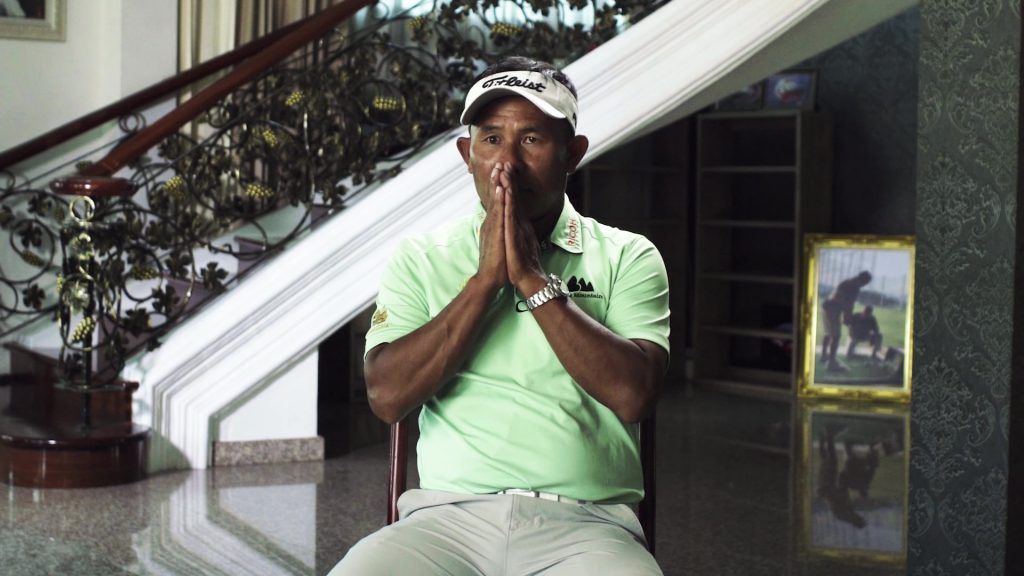
Thongchai Jaidee talks about his time on the Asian Tour and European Tour, breaking down barriers and being a role model for young Thai golfers. My Time is a documentary series in partnership with Rolex going in-depth into Asian Tour players careers.
Thai legend Thongchai hopes to inspire next generation – “In the future I really want to see the young Thai and Asian players perform better than Thongchai Jaidee. I want them to see that I started from nothing but I managed to get where I am today. I want to be their role model.”
[embedyt] https://www.youtube.com/watch?v=BoAFifWy6dE[/embedyt]
Read more about Thongchai’s illustrious career here.

Imagine a golf course consisting of the most iconic and challenging holes on the Asian Tour.
A fictional hybrid-layout that features one of the region’s standout opening holes, one of the finest second holes and goes all the way through to an epic 18th.
A layout that would be the ultimate challenge – where breaking par is a monumental achievement.
Well, just such a virtual course now exists, as an Asian Tour panel of experts has selected the appropriate holes to make up what is the golf course of all golf courses in Asia.
With a par of 70 and length of 7,430 yards, we have appropriately named it The Asian Tour Monster.

To navigate us through The Asian Tour Monster, we asked players and experts to describe each hole – all of which have played key roles in many of the biggest tournaments on the Asian Tour.
Let us know what your think on our social media channels – Facebook, Instagram, Twitter.
Feature: The Asian Tour Monster – Front nine

Taiwan Golf and Country Club
Hole 10 – Taiwan Golf and Country Club
Par: Three
Yardage: 221 yards
Hole scoring average: 3.36
Asian Tour event hosted: Mercuries Taiwan Masters
Hsieh Min-nan, who is one of the true legends of golf in Chinese Taipei, describes this hole as one of the most difficult par-three holes in the world. Considering his lofty standards, this hole is definitely worth including as one of the most difficult on the Asian Tour.
It has a smallish green but it looks tiny when you are standing over 220 yards away, with howling winds holding on to a three-iron or hybrid. You will end up in a deep bunker or a penalty area if you are too far to the left, while a gaping bunker guards the right side of this narrow table-top green, adding to the challenge of this beautiful beast of a hole.
Once you reach the green, you face a putting challenge like no other – the greens at Taiwan Golf and Country Club are renowned for confusing even the best of putters. It is worth noting that during the 2018 Mercuries Taiwan Masters, only seven birdies out of 349 attempts were made on this hole.
“In my opinion it’s the hardest par-three green to hit on the Asian Tour, and maybe in the world! I think I’ve only ever hit the green two times. Most of the time I’m playing to miss the green short because that green is so difficult to hold with a four iron. You can get it up and down from the front part of the green. The best shot I have ever seen on that hole was when I watched one of the Taiwan legends a couple years ago pull out driver and hit this high cut to like 20 feet. It was the best shot I’ve ever seen there. Every time I walk off that green with a par I feel like I’ve made birdie!”
Berry Henson: a winner on both the Asian Tour and Asian Development Tour, who was runner-up in the Mercuries Taiwan Masters in 2018.
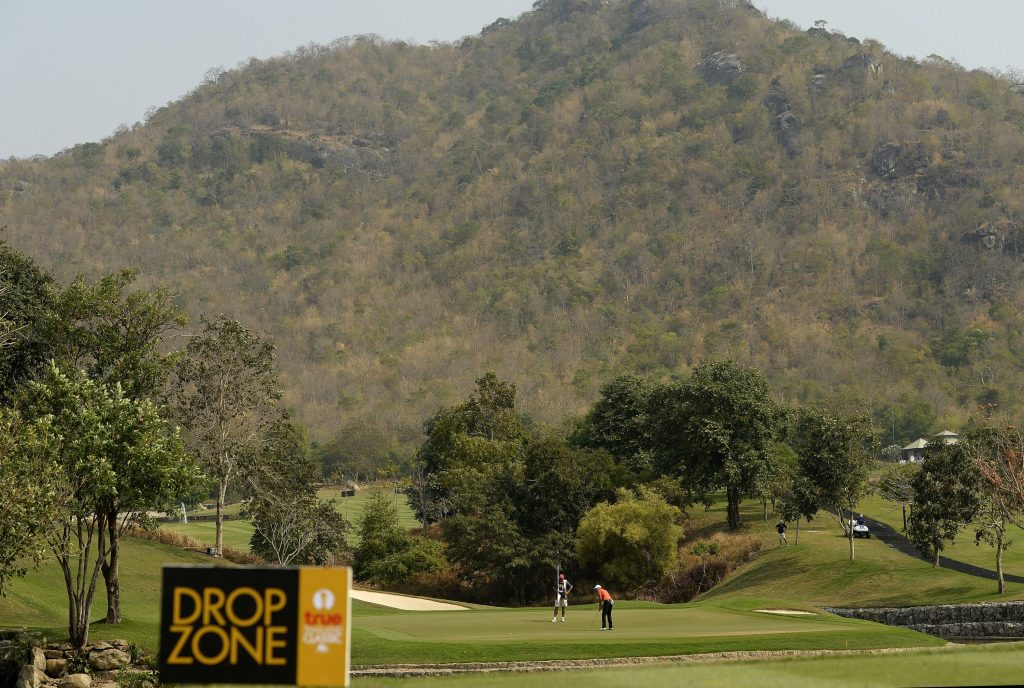
Black Mountain Golf Club
Hole 11 – Black Mountain Golf Club
Par: Three
Yardage: 191 yards
Hole scoring average: 3.2
Asian Tour events hosted: Black Mountain Masters, Thailand Classic, King’s Cup, Royal Trophy
This intimidating downhill par-three is the signature hole at Black Mountain Golf Club. It has a narrow double-tiered green, with two-thirds of it surrounded by water. A wall of trees protects the bail out area on the left, ready to deflect any shots hit in this direction back into the water.
According to two-time Asian Tour winner Rikard Karlberg and resident professional, who is also a Black Mountain club member, he says: “Never think about the water as you can lose shots very easily. You just have to aim and hit it straight to the middle of the green and hope for the best”.
“The 11th hole, the signature hole at Black Mountain, has the Black Mountain hill as its back drop. It is a tough green to hit, especially when the wind is blowing.
There is a feeling the green is an island green – even though it is not.
There is no real bail out on this par three as there is water just right of the green and if you were to pull the shot slightly left then there are over hanging trees and a stream where the ball is most likely to end up. The hole certainly is a challenge and if you walk off with par then most people will be happy.”
Simon Yates: is a two-time winner on the Asian Tour and resident at Black Mountain.
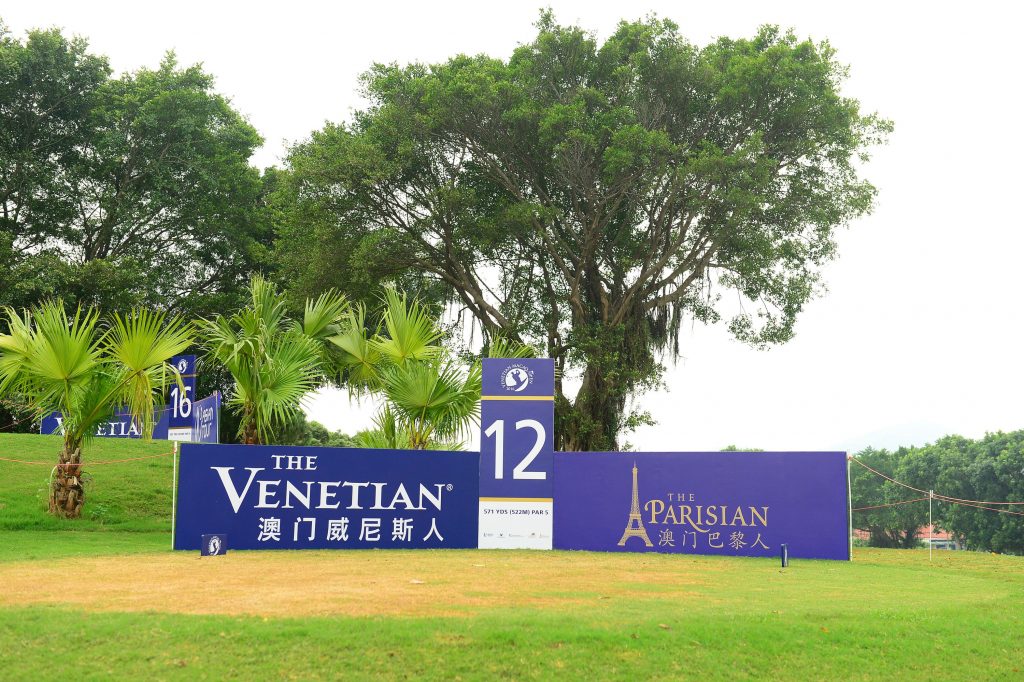
Hole 12 – Macau Golf and Country Club
Par: Five
Yardage: 571 yards
Hole scoring average: 5.2
Asian Tour event hosted: Macau Open
This hole demands astute ball control. Being a mountainous course, it can get very challenging with the wind constantly changing directions due to the many ridges and valleys that intersperse the property.
Firstly, a well struck drive is needed to avoid the troublesome fairway bunkers and to carry the ball over water. An accurate second shot is then required to avoid the bunkers guarding the lay-up area and penalty area on the left of this par five, which stretches and rises across the irregular terrain. This sets you up for a mid to short iron approach shot to a severely sloping two-tier green. Being on the correct tier with your approach shot here is paramount as this green has yielded more than its fair share of four-putts.
India’s Anirban Lahiri birdied this hole in the final round of the 2016 Venetian Macao Open – which was the first of an incredible run of seven birdies to force a play-off with Thailand’s Pavit Tangkamolprasert. Pavit eventually prevailed for this first win on the Asian Tour.
“On that final Sunday [in 2016], I used a driver for my first shot on hole 12. This hole is a long par-five – no one can really reach in two. On the second shot I used a hybrid – you just really need to get it on the fairway. Third shot I had about 100 yards left, so I used a 56-degree wedge which I pitched left of the flag and then made about a six yard putt for birdie. The hole is not as tough as 13, but the green [on hole 12] is very tough, especially if the pin is on the back as there is a huge slope.”
Pavit Tangkamolprasert – a two-time champion on the Asian Tour, and winner of the 2016 Venetian Macao Open.
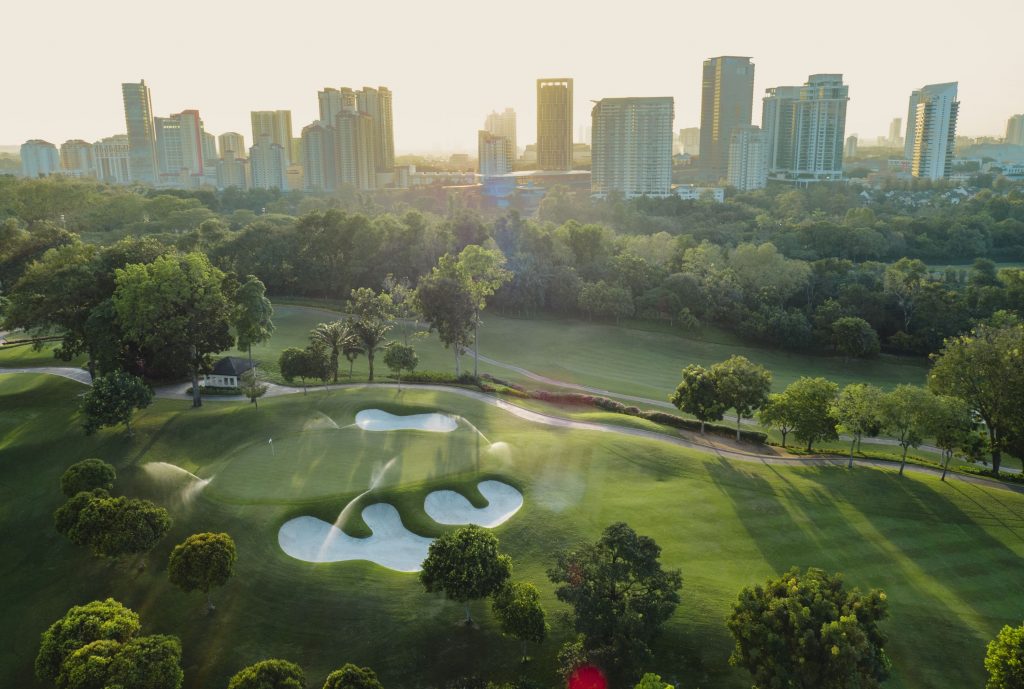
Hole 13 – TPC Kuala Lumpur (West course), Malaysia
Par: Four
Yardage: 459 yards
Hole scoring average: 4.38
Asian Tour event hosted: Malaysian Open
You will need both length and accuracy with your tee shot to play this hole – which is a lengthy uphill hole. A penalty area on the right and thick rough up the left side await wayward drives. A solid mid to long iron is then required to reach the elevated green. The right side of the green is preferred as deep bunkers guard the left side of the long and narrow green. Club selection will be important as the green has three tiers and any mis-clubbed approach shot can result in possibly having to negotiate some lengthy winding putts. Downhill putts will be especially challenging.
“I hit driver off the tee here, making sure I start my ball on the left side of the fairway. On this hole, the one place you don’t want to go is right. I try and hit a little fade as well. Most important is to keep it on the fairway. The toughest part of the hole is the second shot. There is a very high elevation, maybe about seven or eight metres up hill. I normally have a six iron in. I try to hit a draw as, if anything, you want to miss on the right side of that hole. If I walk away with par I will be very happy. So far I have played this hole well in tournaments, with a couple of birdies.”
Danny Chia: a two-time winner on the Asian Tour and four-time champion on the Asian Development Tour.
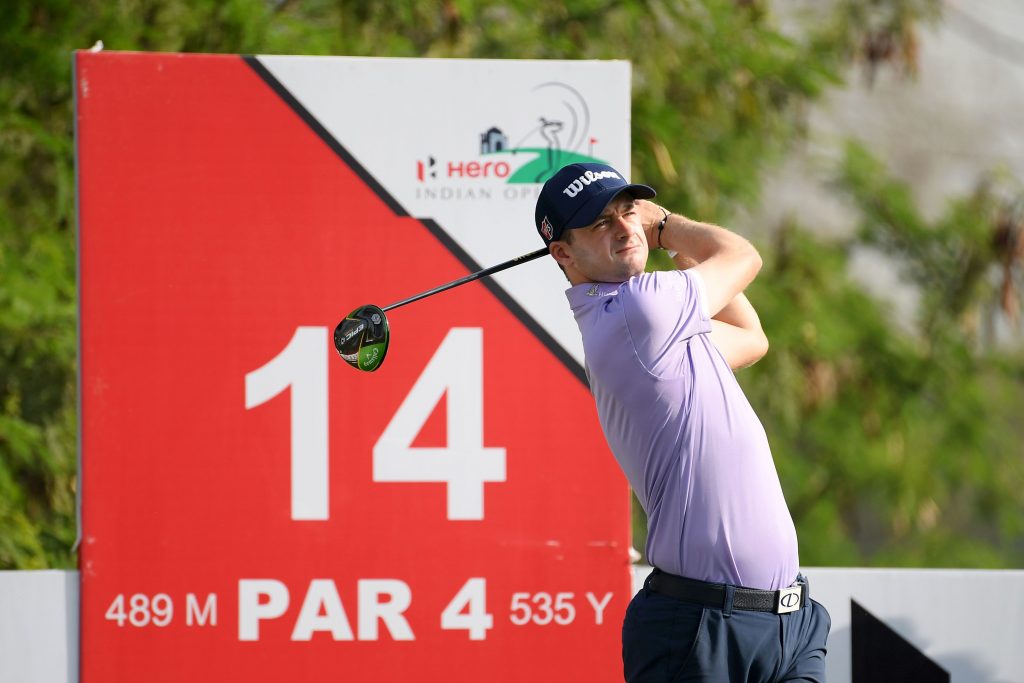
NEW DELHI, INDIA – MARCH 29: David Law of Scotland tees off the 14th hole during round two of the Hero Indian Open at the DLF Golf & Country Club on March 29, 2019 in New Delhi, India. (Photo by Ross Kinnaird/Getty Images)
Hole 14 – DLF Golf and Country Club, India
Par: Four
Yardage: 535 yards
Hole scoring average: 4.53
Asian Tour events hosted: Hero Indian Open, Avantha Masters, Johnnie Walker Classic
The 14th hole at the Gary Player-designed DLF Golf and Country Club is just a ruthless golf hole. Long is an understatement when describing this par-four which demands two massive and precise shots to reach the green. Adding to the challenge is the forced 250-yard carry off the tee over dense scrub that runs down the entire left side. Once you have the green in your sights, you will be faced with a downhill lie and needing at least a long iron to reach an elevated green with steep fall offs on either side.
It is a hole that probably cost American Julian Suri the Hero Indian Open title last year. Suri had a three-shot lead with six holes to play but made a quadruple-bogey eight, after taking six shots to get down from just off the green. He eventually had to settle for a share of fourth place.
“Normally when we play this hole, it is a par-four, otherwise for the club members it is a par-five. My personal view about that hole is that it is the toughest hole on the golf course and one of the hardest in the region. Firstly, for your tee shot you can’t hit a driver, some people do, because it is very narrow and there are some rocks placed beautifully on the right side of the fairway. Then you need to use anything from a rescue to a three-wood to a three iron depending on where your ball ends up, to a green that is a very narrow. You also come in from an angle – the green is basically towards the left side when you are standing in the middle of the fairway. Plus there is a huge swale before the green and on the right hand side of the green. And the green slopes left to right towards the swale. So it is difficult to stop the ball on the green unless you hit a high ball. Even if you try and hit a low shot and run it up you have to hit it way left because the green is all left to right and you have to have a perfect bounce.
If you go into the swale on the right … well the swale is at least 15 feet deep. During the tournament 80% of the golf balls end up there, even though players think their ball is on the green but everything slopes into the swale – where there are a lot of pitch marks. You want to make sure you hit a high lofted second shot onto the green, so it stays on the green. Some people try and take it left of the green but then what happens is it takes a big bounce and goes to the left hand side and you are left with a downhill chip and from there most of the time people chip it over into the swale on the right. Management is very important. A par on that hole is a bonus and you want to make the most of it and if you try and get too smart just try and make a bogey and move onto the next hole. I have never made a birdie there in tournaments, made a double once but normally pars or bogies.”
Jeev Milkha Singh: a two-time Asian Tour Order of Merit champion, and five-time winner on the Asian Tour. He has also claimed four titles in both Europe and Japan.
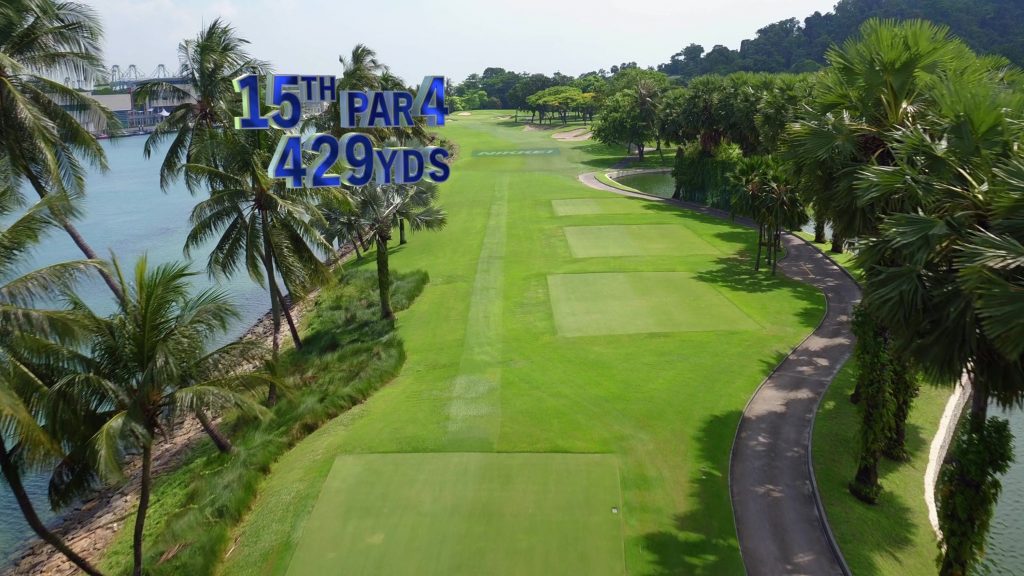
Hole 15 – The Serapong, Sentosa Golf Club, Singapore
Par: Four
Yardage: 429 yards
Hole scoring average: 4.20
Asian Tour event hosted: SMBC Singapore Open
A very intimidating par-four and one that enhances Serapong’s reputation as a true championship layout. The fairway is extremely narrow with a sea channel running all the way down the left side of the hole, where a countless number of balls have found a watery grave. It is also a long par-four that requires full concentration.
“The 15th is a really good hole. Visually intimidating off the tee, it is probably the most difficult tee-shot on Serapong, after the third hole.
I usually aim at the second bunker on the right with a three wood and play a draw. The reason for a draw is that in the worst case if you overdraw it and it ends up in the water you can at least drop the ball up in the fairway and still have a shot at the green. I have seen many players pull it straight left into the sea and have to drop the ball very near from the tee box … it’ll almost always be an automatic double when that happens.
If you are able to hit the fairway, I would say the hole becomes straight forward from there, but I have seen a lot of bail outs to the right.
If you are in the right rough, the second shot becomes tricky as you have to contend with the trees to carry for your approach.
A back left pin is the most difficult pin position on this hole. When the pin is there, we usually just aim for the middle of the green… if not you’d have to contend with the bunker and also water if you go long and left.
The majority of players will a hit fairway wood off this tee, however, there was one round when I played with Phil Mickelson and he pulled out a driver, hit it about 30 yards right of the fairway into the trees, but he was able to hit a really high shot over the trees and get away with par.”
Lam Chih Bing: a winner of 10 titles in the region including one victory on the Asian Tour at the Volvo Masters of Asia in 2008.
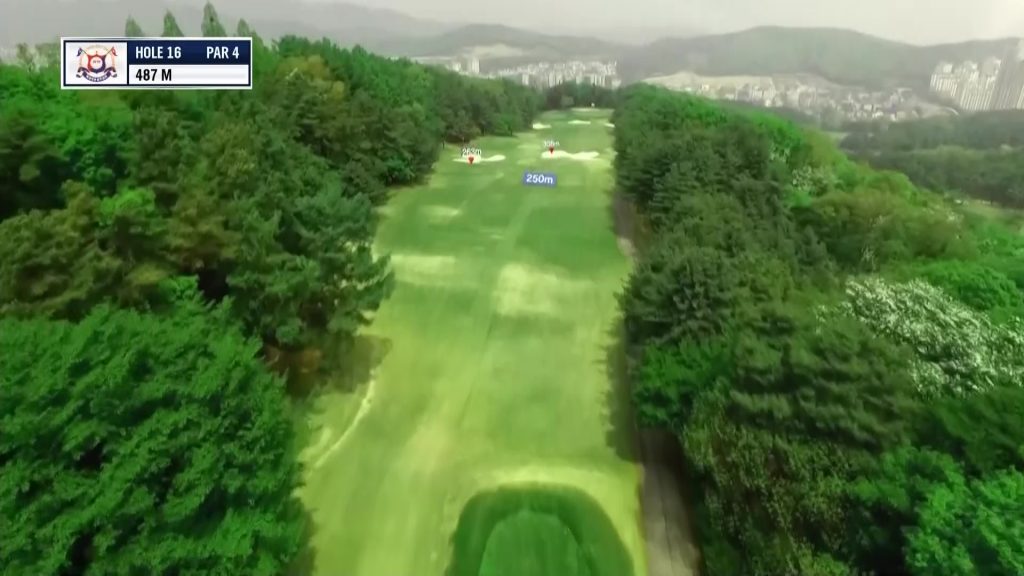
Hole 16 – Namseoul Country Club, Seoul, Korea
Par: Four
Yardage: 533 yards
Hole scoring average: 4.75
Asian Tour event hosted: GS Caltex Maekyung Open
The 16th hole is a straight and long downhill par-four with OB all the way down the right. It requires precision off the tee to a narrow fairway guarded by bunkers on the left and at the end of the landing area. A long iron or hybrid will be needed for your approach shot, however the downhill lie will hinder your efforts at keeping the ball on this green. Bunkers short and over the green are always in play with the OB once again in play down the right.
Prior to the 2017 edition of the GS Caltex Maekyung Open, this hole was played as a par-five for the tournament. After changing to a par-four, it has since become the toughest hole of the tournament for the last three years.
“Nam Seoul’s 16th hole is the hardest hole on the course. On the tee I usually hit five-wood or hybrid depending what club I use for that week. You want to hit something around 260 yards so you are just short of the fairway bunker and not too far from the hole.
I usually have about 200 to 215 for my second depending on how well I strike it. Most of the time I will use a five iron to this green. This hole is so hard because you will have to hit your second shot from a downhill slope, which it makes it so hard to stop the ball on the green, and there are two deep bunkers around the green. This hole is so hard that when I make par on this hole I feel like I made a birdie. One interesting story that I have involves the first round from last year. I had an afternoon tee time and I was playing well and I believe I was leading the tournament at that time, until the 16th hole. I don’t know what happened but I ended up making a quadruple bogey and everything went south from that point…”
Yikeun Chang: winner of the 2019 Yeangder TPC and the 2016 Qualifying School. He was also runner-up at the GS Caltex Maekyung Open in 2018.

Hole 17 – Royale Jakarta Golf Club, Indonesia
Par: Four
Yardage: 459 yards
Hole scoring average: 4.29
Asian Tour event hosted: BNI Indonesian Masters
The 17th hole is a lengthy par-four at Royale Jakarta Golf Club. To master this challenging hole, you need to execute a well-struck tee shot to a less than generous fairway. A penalty area that runs all the way down the right and thick rough down the left will definitely test your nerves. And depending on the wind direction and quality of your tee shot, the approach shot can be with anything from a short-iron to a long-iron, to an undulating green that is guarded by a bunker on the left and water short and to the right of the green.
“That is a great hole, it is definitely one of the most challenging holes, especially for the 17th hole of a golf tournament. For the longest time, I have always played that hole hitting three wood over the little bunker in the middle there because to me it’s the widest part of that fairway, although it is not very wide to begin with. Once you get up to 290 to 300 yards that’s where the fairway gets narrower. Typically the rough has always been thick at Royale Jakarta but the last few years it hasn’t been so, so it’s been manageable. Teddy [Teddy Harmidy his friend, and caddie at the 2019 BNI Indonesian Masters] had me try and hit driver there when we were preparing for the tournament, a few months before. He said if I am going to caddie for you I want you to try this. So I did that and hit it out there and once I saw where my ball ended up, even if it wasn’t in the fairway, I realized I am only hitting a nine iron at most into the green. Normally with a three wood off the tee I am hitting maybe a six, seven or eight iron into the green. So it’s been an ongoing debate, what’s more important? Hitting in the fairway or long. So I started to change my mind set. And I started to realize I do hit it quite far so I should take advantage of that on some of these longer holes, even if you are going to be in the rough. The green slopes left to right and so anything left of that green is dead. Where they put the pins there is quite challenging. I actually bogeyed it the first two days last year and birdied it the third round and parred on the last day. You need to hit a good second shot with that green. There are not many flat spots on the green, maybe one. A par on the hole is very good.”
Danny Masrin: a seven-time winner on the PGA Tour of Indonesia, who finished equal fifth in the 2019 BNI Indonesian Masters.
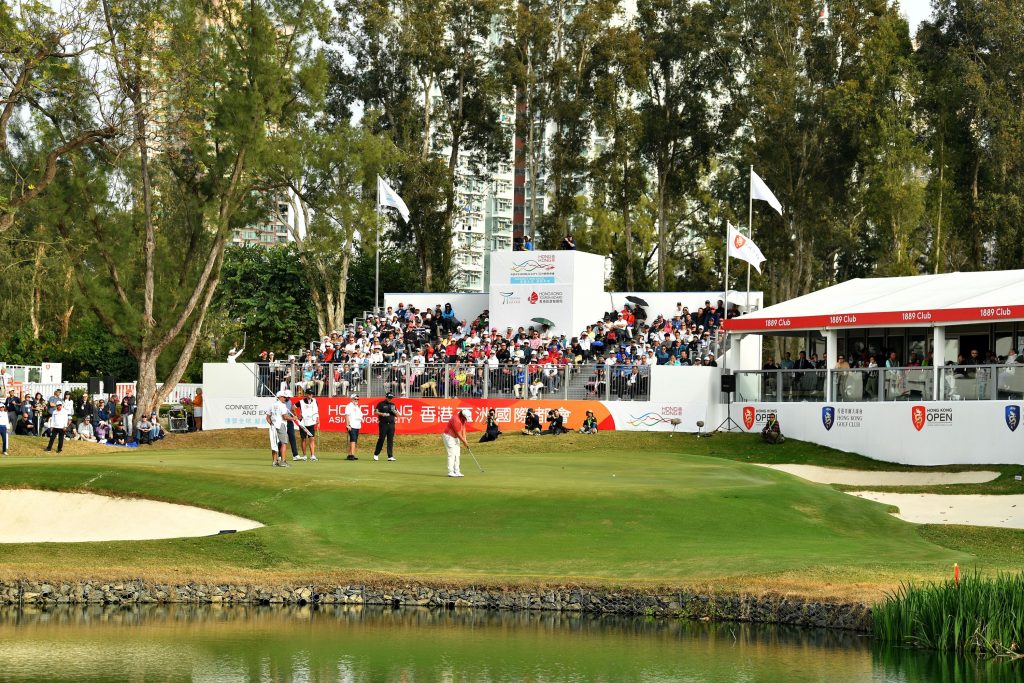
HONG KONG- The Hong Kong Open at the Fanling Golf Club, Fanling, Hong Kong, the Asian Tour USD$ 1 million event is the season opener. Picture by Paul Lakatos / Asian Tour.
Hole 18 – Composite Course, Hong Kong Golf Club
Par: Four
Yardage: 410 yards
Hole scoring average: 4.281
Asian Tour events hosted: Hong Kong Open, Alfred Dunhill Masters, Johnnie Walker Classic
Known as “The Ultimate”, this is the closing hole on the Eden Course at the Hong Kong Golf Club and also the final hole of the Composite Course – a famous layout consisting of the best holes of the Eden and New Courses, specifically configured for the Hong Kong Open.
It is a hole deeply ingrained in the rich history of Asian golf, and viewed as one of the great amphitheatres of tournament golf globally.
Though not a long par-four, by modern-day standards, it demands the utmost respect, and requires the fullest care and consideration.
The hole’s statistics at this year’s Hong Kong Open, tell a familiar story: measuring 410 yards, it was ranked the second hardest with an average score of 4.281; there were just 40 birdies, 215 pars, 101 bogeys, 19 double-bogeys and two “others”.
Off the tee, most players will favour a long iron to the widest part of the fairway on the left. However, if you are brave enough, you can choose to go with a three-wood or driver and attempt to thread the ball through the narrowest part of the fairway to set up an easier approach shot. With trees and OB threatening on the left and a dense cluster of trees and bunker to the right of the fairway, it is risk verses reward.
Having chosen your strategy and, hopefully, successfully executed it, it is time to take on the green. Although the elevated green is large, it is severely sloped from back to front, so it is always preferred to be putting from below the hole. There is a large lake in front of the green with bunkers the front and right. And any shot missed left will leave you in gnarly rough with a slim chance to get up and down.
It has been the setting for a wealth of gripping and well-documented drama over the decades.
Who can ever forget the heroics of Lin Wen-tang’s memorable play-off victory over Francesco Molinari and Rory McIlroy at the Hong Kong Open in 2008. Lin produced one of the finest shots ever seen on the 18th: after hooking his tee shot, he played a spectacular approach out of trees, over water, and a bunker, to within inches of the pin.
And, in 2011, McIlroy recorded his maiden triumph at the Hong Kong Open in remarkable fashion when he holed out from a greenside bunker at the last to finish two shots clear of France’s Gregory Havret.
“I usually hit three-wood these days, try to hit a fade off the trees on the left but usually end up in the trees! At the Hong Kong Open in 1996, I hit a two-iron off the tee and then an eight-iron to about 12-feet. I made the birdie putt to finish fourth.
In the 1996 Alfred Dunhill Masters I holed a bunker shot from the right bunker for birdie to finish T11, I think. There were massive crowds that year. Langer, Els, Ballesteros and Monty were all playing. There must have been 20,000 people there that day.”
Dominique Boulet: a former Asian Tour player and Hong Kong number one. Now a highly respected television commentator and long-time member of the Hong Kong Golf Club.
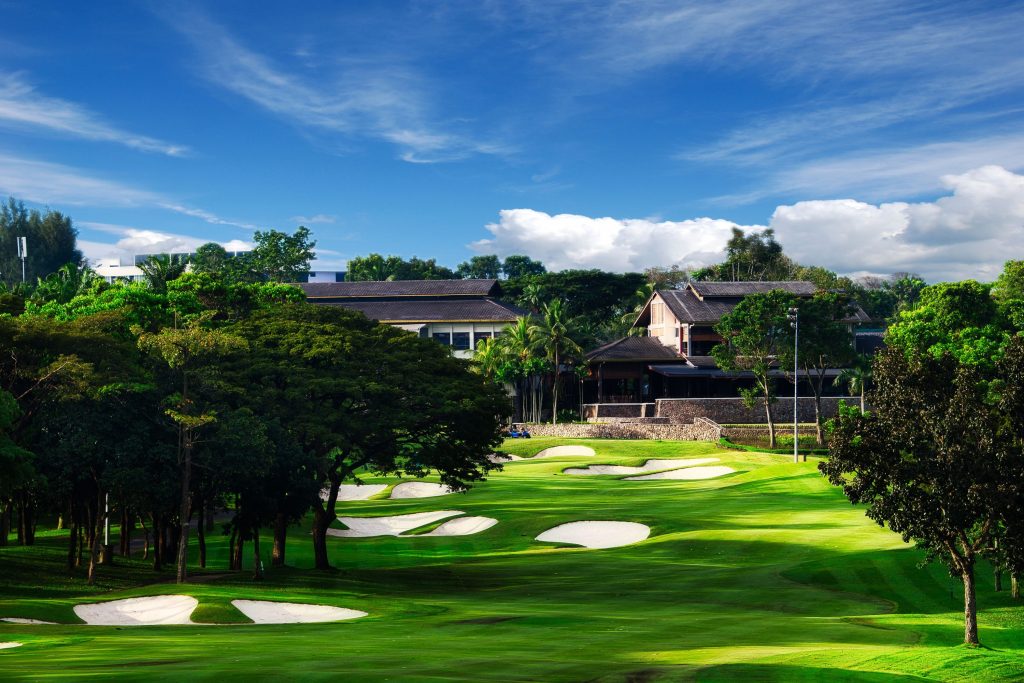
When American rookie Trevor Simsby holed a four-foot birdie putt to beat Andrew Dodt, from Australia, in a sudden-death play-off at the Bandar Malaysian Open in March, it not only sealed his first win on Tour but the occasion also helped cement an important relationship that has lasted over two decades.
Kota Permai Golf & Country Club, the tournament’s venue, has been the proud host of events on the Asian Tour since first staging the Volvo Masters of Malaysia in 1998 – the year the club opened.
And over the past 22 years it has staged a wealth of Tour events, including: two Malaysian Opens, the Selangor Worldwide Masters twice, six Volvo Masters and a pair of World Cup Qualifiers.
It has been a special venue on Tour ‒ something that Thailand’s Thaworn Wiratchant will agree with having won the 2001 Volvo Masters of Malaysia and Selangor Worldwide Masters in 2012 on Kota Permai’s pristine playing surfaces.
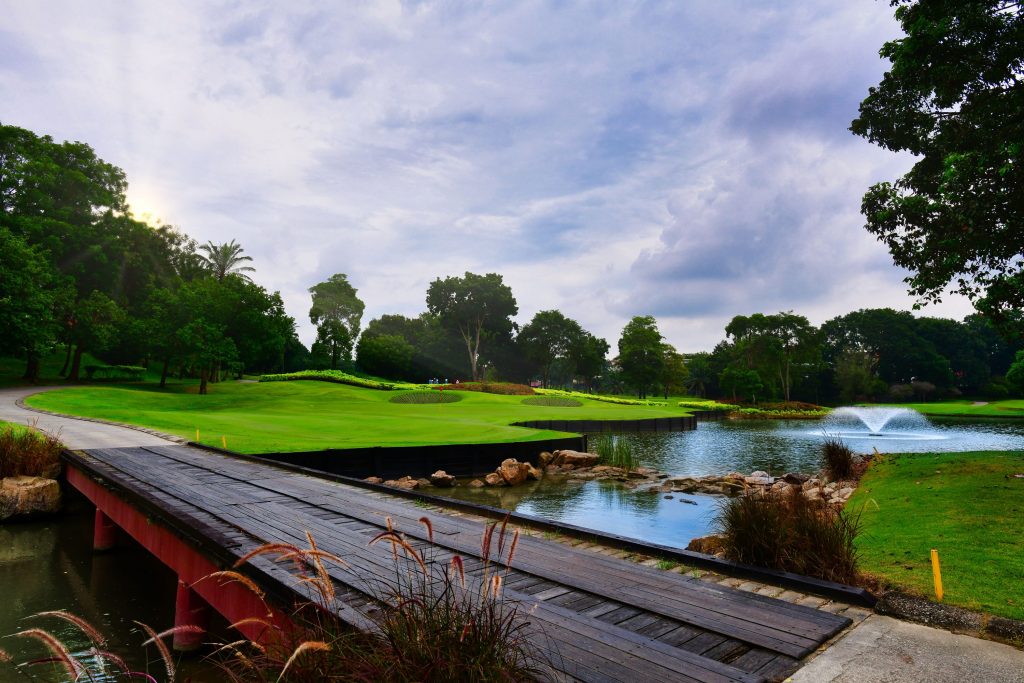
Hole No. 2 at Kota Permai GCC
Many will also remember American Kevin Na ‒ aged just 19-years-old ‒ winning the Volvo Masters of Asia at Kota Permai in 2002, before departing on a highly successful and lucrative career on the PGA Tour.
In August, the popular Kuala Lumpur venue took another exciting step forward with its’ Tour association by becoming part of Asian Tour Destinations – an exclusive network of world-class golf venues, with direct ties to the Tour.
The other current Destinations venues include: Sentosa Golf Club in Singapore, Black Mountain Golf Club in Hua Hin, Thailand, and the Classic Golf & Country Club in New Delhi, India. Additional world-class Destinations will be added to the network over the coming months.
The Asian Tour Destinations brand offers a wide range of benefits to its members and the Tour, helping them to achieve their commercial and strategic goals.
It provides an affiliate membership programme between the associated venues – which have a collective membership base of 7,500 golfers.
Also, being a part of the network means that each venue is certified Tour calibre and operates a comprehensive range of facilities and services to their members and guests under tournament-ready conditions all-year round.
Among the core benefits, Asian Tour members will be able to play and practice at each venue – allowing for the members at each club to enjoy direct engagement with the region’s best golfers.
“This is a very exciting development – one we have eagerly been anticipating. In terms of what we are looking forward to, it is pretty much threefold,” says Tang Meng Loon, Director of Club, Township & Property Management at Gamuda Land – the owners of Kota Permai.
“Firstly, more involvement with the Asian Tour – to be a host venue for tournaments or a platform for any programmes sanctioned by the Tour.
“Secondly, seeing Tour players here at Kota Permai away from tournaments will be amazing. We will be able to get their feedback for improvements, plus members and guests will really enjoy seeing them here, whether playing, practicing or socializing in the clubhouse. It’s going to be great to see them here and it will definitely increase interest to play here.
“Thirdly, we will be able to foster interclub relations with the management teams of the other Asian Tour Destinations’ partners, exchange advertising and promotion support, and welcome their members to Kota Permai, relishing the chance to host them.”

Hole No. 16 at Kota Permai GCC
In addition, by aligning themselves to an even greater degree with the Asian Tour, the club are hoping to achieve one of their key objectives: to see their venue continue to rise from being one of Malaysia’s top golf club’s – a position it proudly holds today – to one of the premier golfing Destinations in the region.
“We want to provide the best possible experience to all who walk through our doors and we want to constantly improve in all areas. With Asian Tour Destinations, this is now very possible,” added Tang.
The club currently has over 4,000 members and averages 5,900 rounds a month. And it is well known for being the ultimate recreational hub, for as well as boasting an 18-hole golf course – designed by Ross Watson – it also has a pro shop, driving range, gymnasium, badminton, squash and tennis courts, swimming pools, sauna and steam baths, F&B outlets, function rooms, and a children’s playground.
Says Tang: “We have a constant drive to improve in all areas – whether it be in operations, branding, marketing, strategic partnerships, or administration.
“We are continuously working on the maintenance and upgrade of the golf course, plus the provision and upkeep of world-class club facilities and amenities that offer excellent customer service.”
This policy of progression has resulted in the club being the recipient of a host of important accolades – including the coveted “Malaysia’s Best Golf Course” award in 2014, 2016, 2017 and 2018 at the World Golf Awards. And, it has also earned similar honours at the Asian Golf Awards over the years.
And, the club have weathered the storm caused by the coronavirus pandemic by gradually resuming business.
“As per government directives, we had to close the club and cease all operations earlier in the year. Since the beginning we have followed the strict standard operating procedures but we are delighted to say we are almost back to normal – just operating under the ‘new norm’ of things,” said Tang.
Simsby, for one, will be happy to hear that.
Said the American after his win: “I really felt good about the golf course, and was in awe of how good the condition was. It was in tremendous shape all week.”
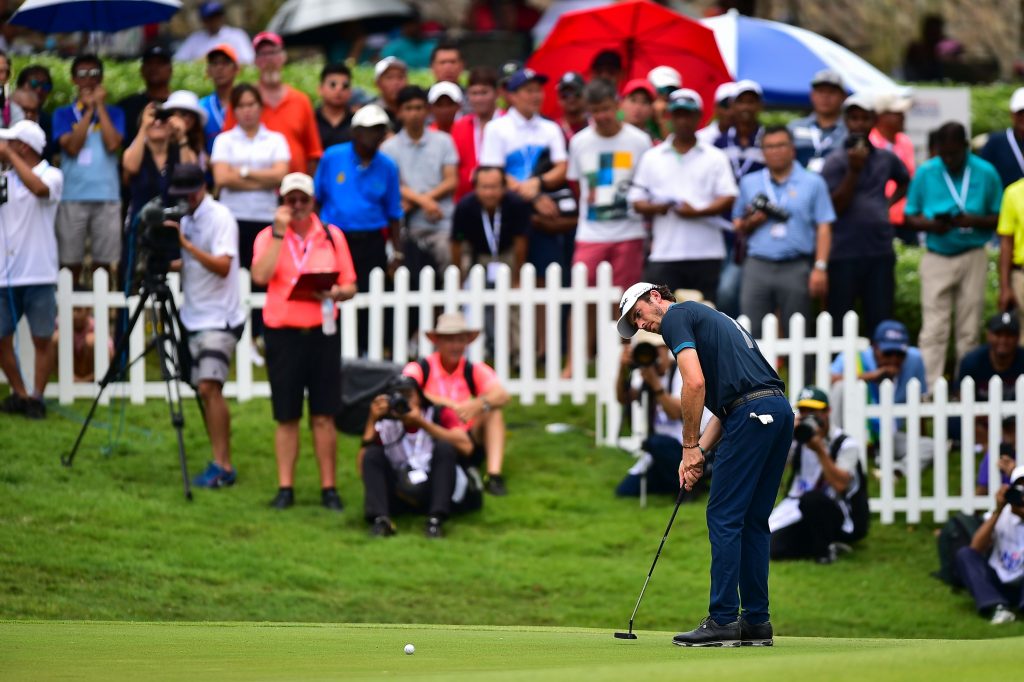
Trevor Simsby of the United States

[embedyt] https://www.youtube.com/watch?v=BbyV4DLW_d0[/embedyt]
Thailand’s Kiradech Aphibarnrat may be back enjoying playing on the PGA Tour but he never forgets his roots.
“The Asian Tour is like my first school,” said the 31-year-old, the 2013 Asian Tour Order of Merit champion and three-time winner on the Tour.
“The Asian Tour opened the gate for me to play in Japan, play in Europe, play World Golf Championships and Majors, and that was the way to get to the PGA Tour,” added Kiradech, who in 2019 became the first Thai to become a member of the PGA Tour.
He played in last week’s Safeway Open – the 2020/21 season-opener on the PGA Tour – and missed the cut but it was his first event back following a long break from the game caused by Covid-19.
He had opted to skip the restart of the PGA Tour in June, having flown home to Bangkok in mid-April following the initial suspension of the Tour due to Covid-19.
He is now back at his US base in Orlando, Florida, in search of his first win on the PGA Tour.
Also a four-time winner on the European Tour and a three-time champion on the Asian Development Tour, he counts his first win on the Asian Tour – the 2011 Sail Open – as being key to his success.
“For me the first win was the most important,” said Kiradech, who turned professional in 2008.
“In that two years, it was quite tough for me, I didn’t know how to win. I was scared of winning, every time I took a lead, I had no goal, I had no target,” he said.
“The Sail Open unlocked everything. You want to count two or three, you have to count one.”
His aggressive and fearless style of play fits well with his love of fast cars.
He adds: “I am always thinking about the target. I don’t have any swing thought in my head. I just want to make sure I just hit right at the target, every single shot. I have no fear in my mind, I see the target and just commit to it.”
“I really like motor sports, every fast car. When I come back from the toughest golf event, and I feel I need to lose something and relax, I spend time with my car. You have to know the limit of the car, the limit of yourself.”
Ends.
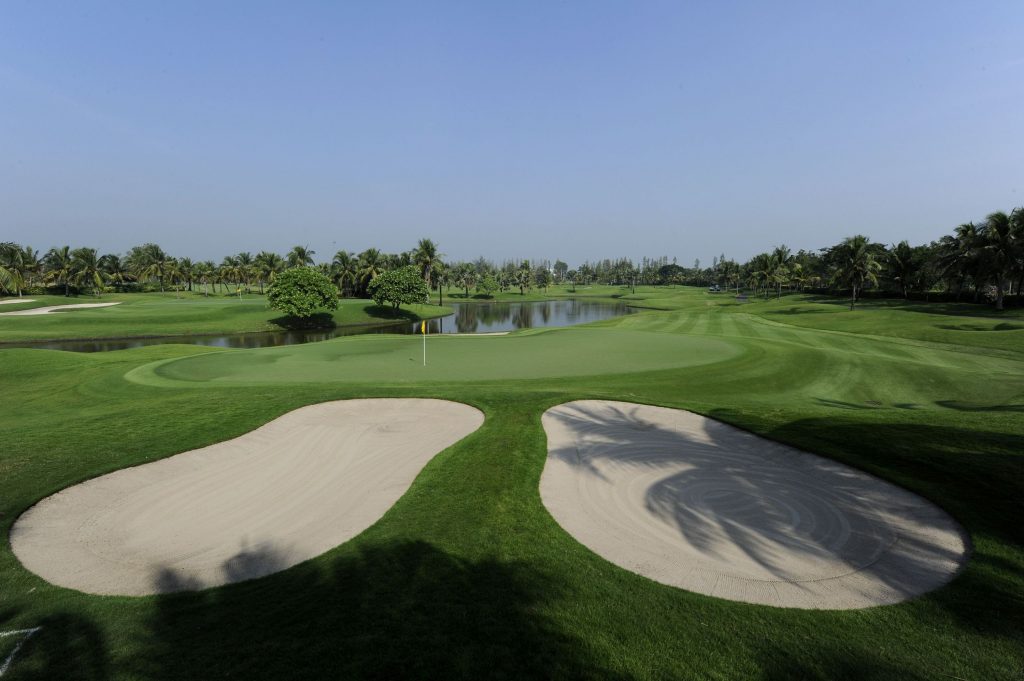
Imagine a golf course consisting of the most iconic and challenging holes on the Asian Tour.
A fictional hybrid-layout that features one of the region’s standout opening holes, one of the finest second holes and goes all the way through to an epic 18th.
A layout that would be the ultimate challenge – where breaking par is a monumental achievement.
Well, just such a virtual course now exists, as an Asian Tour panel of experts has selected the appropriate holes to make up what is the golf course of all golf courses in Asia.
With a par of 70 and length of 7,430 yards, we have appropriately named it The Asian Tour Monster.
To navigate us through The Asian Tour Monster, we asked players and experts to describe each hole – all of which have played key roles in many of the biggest tournaments on the Asian Tour.
Let us know what your think on our social media channels – Facebook, Instagram, Twitter.
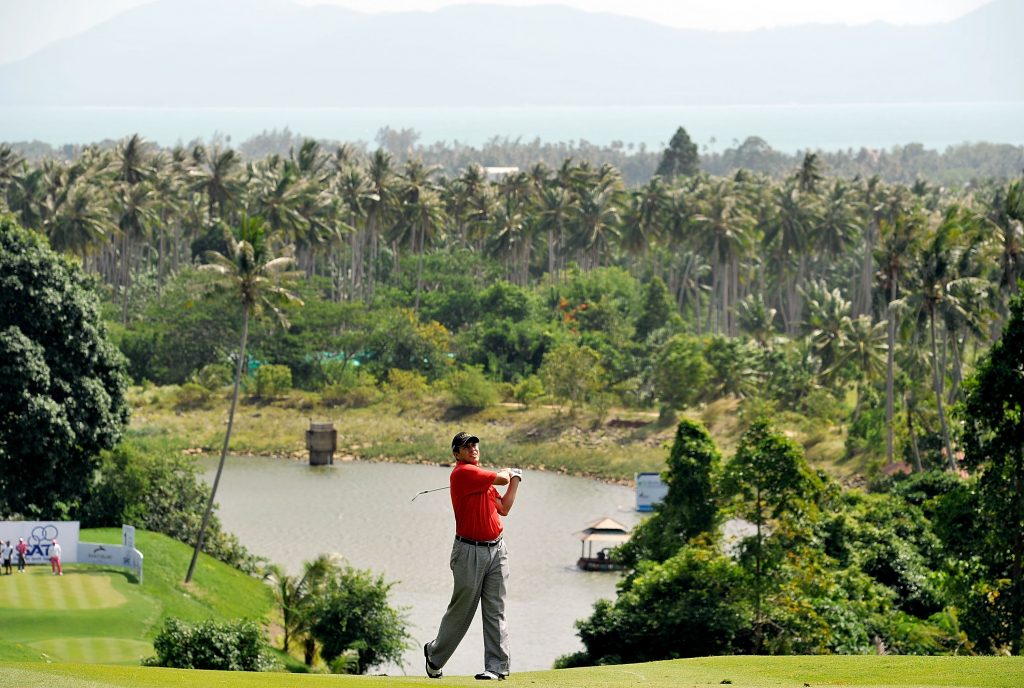
KOH SAMUI, THAILAND – JUNE 17: Adlison Da Silva of Brazil in action at Santiburi Samui Country Club on June 17, 2012 in Koh Samui, Thailand. (Photo by Paul Lakatos/Asian Tour/Asian Tour via Getty Images)
Hole 1 – Santiburi Samui Country Club, Koh Samui, Thailand
Par: Four
Yardage: 339 yards
Hole scoring average: 4.34
Asian Tour event hosted: Queen’s Cup
Where better to start this iconic course than the holiday island of Koh Samui in Thailand.
But, as with all the holes on The Asian Tour Monster, it is not a hole where you can take a vacation.
Contrary to the name of the hole – which is ‘The Flat Land’ – it is a steep uphill and treacherous opening par four, also widely known as the “Beast of Samui”.
Although it only requires a long-iron or a hybrid off the tee, the precarious elevated fairway is fringed with penalty areas and rocky outcrops. Provided you manage to find the fairway, a mid-iron will then be required for your approach shot. The severe two-tier green which is also elevated will require all your attention as it will most likely yield three putts or more if you are on the wrong level with your approach shot.
The hole is normally played as the 10th by the club members.
“A tall tree is planted just right of the buggy path about 180 yards off the tee which overhangs the fairway. I have seen balls hit that tree and bounce right into the jungle; drop straight down onto the buggy path and basically roll back down to the tee (because of the massive upslope); or hit the tree and disappear altogether.
The second shot – if the fairway is successfully found – will be anywhere from 160 to 180 yards to a green 15 yards higher than the fairway. The green is two tiered – with the tier itself close to four feet.
Hit the ball on the top tier when the pin is on the lower level and players will putt the ball off the green, without a doubt. Hit the ball on the lower tier when the pin is set on the top level … well then players will feel a flex in the putter shaft because of the unusually big swing they have to make.
The placement of this hole, as the opening hole, is perfect to ruin a good round of golf.”
Anthony Kang: a three-time Asian Tour winner and now part of the Asian Tour’s television commentary team.
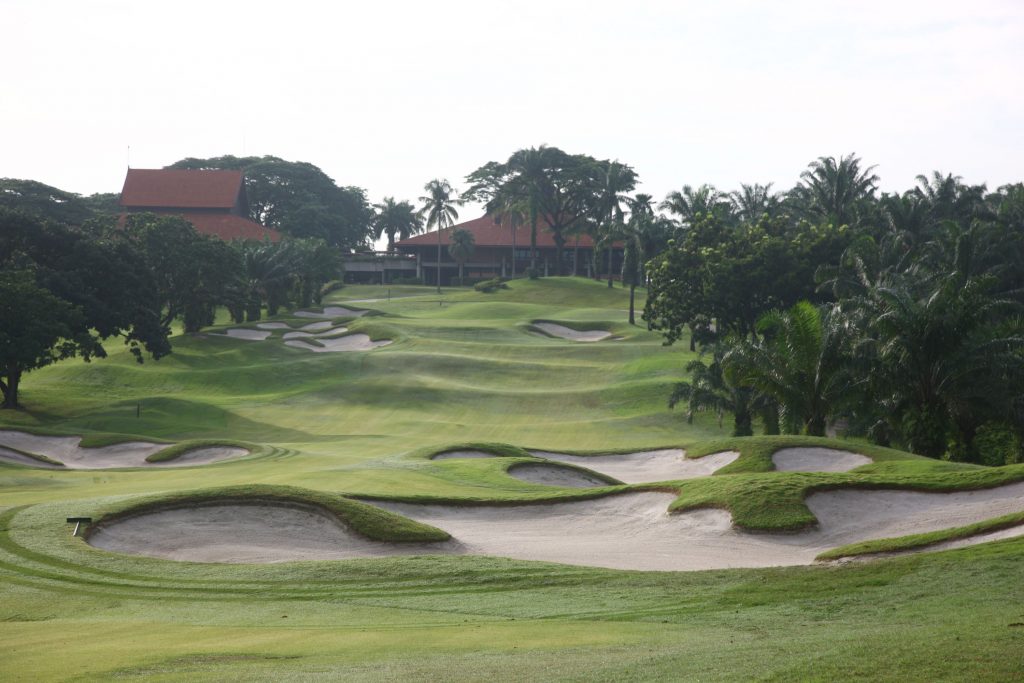
Hole 2 – Saujana Golf & Country Club (Palm Course), Malaysia
Par: Four
Yardage: 493 yards
Hole scoring average: 4.27
Asian Tour events hosted: Maybank Championship, Malaysian Open
The second hole of the Palm Course at Saujana Golf & Country Club is a true test. Its length alone is enough to make you gasp at what awaits. A very narrow fairway flanked by several bunkers, palm trees and dense jungle on the right waits to punish any wayward drive. The second shot requires a mid to long iron to a green where the surface is not visible due to the steep elevation change. Multiple bunkers encompass the large two-tiered green – so making sure your approach shot is on the correct level is imperative.
“The second hole at Saujana is a bit of a difficult one because it is quite long. Much depends on which way the wind is blowing, if it is a little into the wind I will aim down the left with a driver with a little fade – to get past the fairway bunker on the right. But if there is no wind, and conditions are favourable, I will hit a three wood down there.
For the second it can anything from a six to a nine iron into the green – depending on where the pin and wind is. Normally I just try and get my shot to the middle tier if the pin is at the back or if the pin is at the front I always try to get it to the front edge – because if you don’t get up on the green it rolls back down. Definitely stay away from the right hand front bunker because it is just dead in there, because it is so deep. It is just one of those holes where you have to respect making a four and get out of there and you are happy with it.”
Scott Hend: a 10-time winner on the Asian Tour, the 2016 Asian Tour Order of Merit champion and winner of the 2019 Maybank Championship – played on the Palm Course at Saujana.

Hole 3 – Kurmitola Golf Club, Bangladesh
Par: Four
Yardage: 448 yards
Hole scoring average: 4.5
Asian Tour event hosted: Bangabandhu Cup Golf Open
With its tree-lined fairways and intimidating water features, the third hole at Kurmitola Golf Club can challenge every aspect of your game. Off the tee you need a well-struck drive to the corner of a narrow fairway, which doglegs to the left. Bunkers await on either side to swallow any stray drive and any attempt at cutting the corner can result in disaster – as an OB looms nearby. There is also the possibility of losing your ball due to the dense treeline. Even if you manage to negotiate the tee shot, you are still left with a long-iron to a shallow undulating green which yields very few birdies.
“I grew up on this course and we always play it as a par five. For me this hole is a standard par five and as one of the shorter hitters on Tour I can handle it. But when the Asian Tour are here in Bangladesh we play it as a par four and it is a really hard hole for all of us!
But now days I am hitting it a little bit longer and I can make birdies more often here. I had a chat with myself and said I have played many par fours on Tour that are more difficult than this hole, so I am now mentally stronger playing the hole.
Before, I would play driver, then lay up 100 yards to the pin because I am very strong anywhere from 100 yards. Nowadays, I play driver and then a 22-degree hybrid.”
Siddikur Rahman: a two-time winner on the Asian Tour, two-time champion on the Asian Development Tour, and the first golfer from Bangladesh to win on the Asian Tour – at the Brunei Open in 2010.
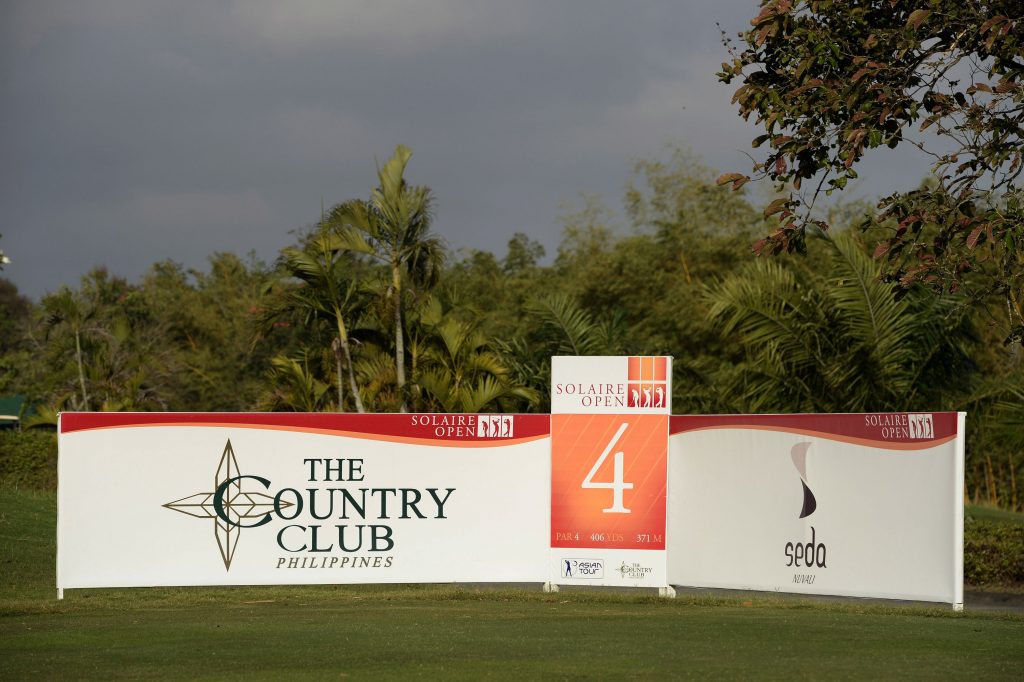
MANILA-PHILIPPINES-The Solaire Open at The Country Club, Manila, Philippines, March 13-16, 2014. a US$ 300.000 Asian Tour event. Picture by Paul Lakatos/Asian Tour.
Hole 4 – The Country Club, Philippines
Par: Four
Yardage: 406 yards
Hole scoring average: 4.52
Asian Tour event hosted: Solaire Open
On this slight dogleg right par-four, a driver is usually required as the further you hit, the wider the landing area is going to be. The purpose-built gap in the fairway to intentionally stop players from laying up is just merciless! Your thought process is tested even more with the OB to the left and water all the way down the right. Once you have recovered from the stress of the tee shot, a small elevated green awaits – which, if you miss the green with your approach, is very difficult to get up and down from.
The Country Club hosted the Solaire Open in 2014 which saw Canada’s Richard T. Lee triumph. Lee double bogeyed the fourth hole on the final day, but recovered brilliantly to claim his first Asian Tour title. That week there were two quintuple bogeys and five quadruple bogeys on the fourth.
“It is a narrow hole with a wind blowing normally, making it a real test. As the wind always blows right to left you have to start the ball at the ravine on the right otherwise you are in danger of going OB left. The fairway is only about 25 metres wide and with the wind and distance it plays quite long, so you need a driver and a mid to long iron to get to the putting surface.”
Koh Dengshan: a former Singapore national player, now Asian Tour regular and touring professional with Sentosa Golf Club.

SINGAPORE – Serapong course at Sentosa Golf Club, Singapore, September 10-15, 2017. Picture by Paul Lakatos/Sentosa Golf Club.
Hole 5 – The Serapong, Sentosa Golf Club, Singapore
Par: Four
Yardage: 486 yards
Hole scoring average: 4.23
Asian Tour event hosted: SMBC Singapore Open
The signature hole on the Serapong Course at Sentosa Golf Club boasts wonderful views of the Singapore skyline that look out onto one of the busiest ports in the world. However, do not allow these views to distract you. This demanding par four, especially when played into the wind, requires your best drive of the day to give yourself the shortest possible approach shot into this shallow and firm green. For shorter hitters this may still require a wood.
The landing area off the tee is fairly generous with large bunkers on either side of the fairway. However, club selection for your approach shot needs to be spot on. A yawning waste bunker stretches its way up the right side of the fairway ready to swallow any mishit shot, and any over-clubbed shot will likely end up in the sea!
“I really dreaded playing this hole during tournament play, simply due to its sheer length. Pars, let alone birdies, were hard to come by, especially when the pin was tucked on the right portion of the green where the water starts to come into play.
When this hole plays its full length, I would need to hit a solid drive and then try to figure out how to keep the ball on the firm green with a long iron in hand.
I think my greatest joy playing this hole came when, on one occasion, my drive hit a sprinkler head and gave me an extra 40 yards, making my approach shot that much shorter, but I still made a bogey!
Make a par on this hole and you will definitely gain at least half a shot on the field!”
Unho Park: an Asian Tour player for 20 years, now a Tour administrator.

Hole 6, par-3.
December 22, 2010. Thai Country Club, Bangkok, Thailand. Mandatory credit: Richard Castka/Sportpix International
Hole 6 – Thai Country Club, Bangkok, Thailand
Par: Three
Yardage: 227 yards
Hole scoring average: 3.17
Asian Tour events hosted: Thailand Open, Volvo Masters of Asia, Asian Honda Classic
The par-three sixth hole is the signature hole at Thai Country Club. It is a long par three over water with strong head winds more often than not. The smart play is to aim for the left side of the green in order to avoid the penalty area and bunker on the right. However, if you stray too far left, the undulations will most certainly throw your ball further away from the green, leaving a tricky up and down to make par. This is just a brute of a par-three where its sheer length just makes playing this hole strenuous.
American John Catlin – who recently won the Andalucia Masters at Valderrama on the European Tour – parred the hole in his first three rounds during the 2019 Thailand Open and made birdie on Sunday, which paved the way for him to secure his fourth Asian Tour title.
“It is a long par three. Off the back it is about 220 – 230 yards to the middle of the green. The wind mostly blows in from the right, so I would have a three iron or five wood. There is a bunker and water on the right side so anything from the middle of the green to the left side is the perfect shot. I will take a three any day there. It is not a birdie hole. You have to be conservative. I had four pars during the Thailand Open in 2018 when I won there, I didn’t lose any strokes there but didn’t make any either.”
Panuphol Pittayarat: winner of the 2018 Thailand Open at Thai Country Club – which is his home club.

SINGAPORE – Serapong course at Sentosa Golf Club, Singapore, September 10-15, 2017. Picture by Paul Lakatos/Sentosa Golf Club.
Hole 7 – The Serapong, Sentosa Golf Club, Singapore
Par: Five
Yardage: 587 yards
Hole scoring average: 5.01
Asian Tour event hosted: SMBC Singapore Open
You may think a par-five that averages near its par in tournament play is a simple enough hole but on the seventh hole on The Serapong, the devil is in the details. You are greeted on the tee with a magnificent turquoise ocean canal stretching the full length of the hole on the right.
With little to no rough on the right-hand side of the fairway, shots that veer right will almost certainly find the drink. The left side of the hole also intimidates you with dense tropical jungle. If you are skilled enough to thread your tee shot between the fairway bunkers, you are left with a very tricky lay-up that needs to be precisely planned and executed to the narrowest part of the fairway.
Any miscue can be calamitous as this year’s SMBC Singapore Open champion, Matt Kuchar, found out by carding an eight in the final round. After a poor tee shot, which went left into the trees, an unexpected air shot ensued while trying to extricate his ball from tree roots. A pulled approach shot, which ended up out of bounds, also did not help his cause. Remarkably, he did not drop a shot after, played the back nine in four under, and beat Justin Rose by three!
“It is a very good hole. It depends how you drive that hole. If you hit a bomb off the tee, 320 yards, you can reach the green in two. But then you still have to hit a quality shot to get on the green. I don’t hit the ball so long these days so I lay up with a three wood, then a four iron and a pitching wedge or nine. The hole is also one of the most scenic on the course.”
Mardan Mamat: a five-time Asian Tour champion and Singapore’s pioneering professional golfer.

MANILA, PHILIPPINES – The ICTSI Philippine Open at the Wack Wack Golf and Country Club on February 9-12, 2012 in Manila, Philippines. Photo by Paul Lakatos/Asian Tour.
Hole 8 – Wack Wack Golf Club, Philippines
Par: Three
Yardage: 191 yards
Hole scoring average: 3.55
Asian Tour event hosted: Philippine Open
The original design of this eighth hole was a lot shorter, requiring only an eight or nine iron to a postage-stamp type green, which was raised even higher than it is today. With its increased length and slightly lowered green, it is still as formidable as ever and can mentally rattle anyone’s nerves when standing on the tee box.
The view of a severely elevated narrow green sloping from back to front and guarded by multiple deep bunkers gives birth to unimaginable scenarios if you fail to hit this green. Although it may sound simple to blast out of the bunkers or chip onto the green after missing it, the nature of the green makes it almost impossible to get the ball on the green when trying to recover from the left or right.
“When I won the Philippine Open in 2008, that hole was played as the 17th hole. And it is funny because having played Wack Wack so many times, amongst friends we have always talked about what you would do if you go into that hole with a one-shot lead. And funny enough, it happened to me – I had a one shot lead in the Philippine Open in 2008. If you have played it long enough, and as much as you want to hit the green, you know you must miss it to the right.
Back then it was only an eight or nine iron but after I won they lengthened it from the back tees, it’s like a six iron now. So what I did was I made sure I aimed a bit more right and tried to hit a good shot, fortunately it landed on the green and just rolled off and ended up in the right bunker. The guy I was up against, Gavin Flint, also did the same thing, and we ended up making bogies but a par was good enough for me to win on the last.”
Angelo Que: a three-time champion on the Asian Tour and a winner on the Japan Golf Tour Organization.
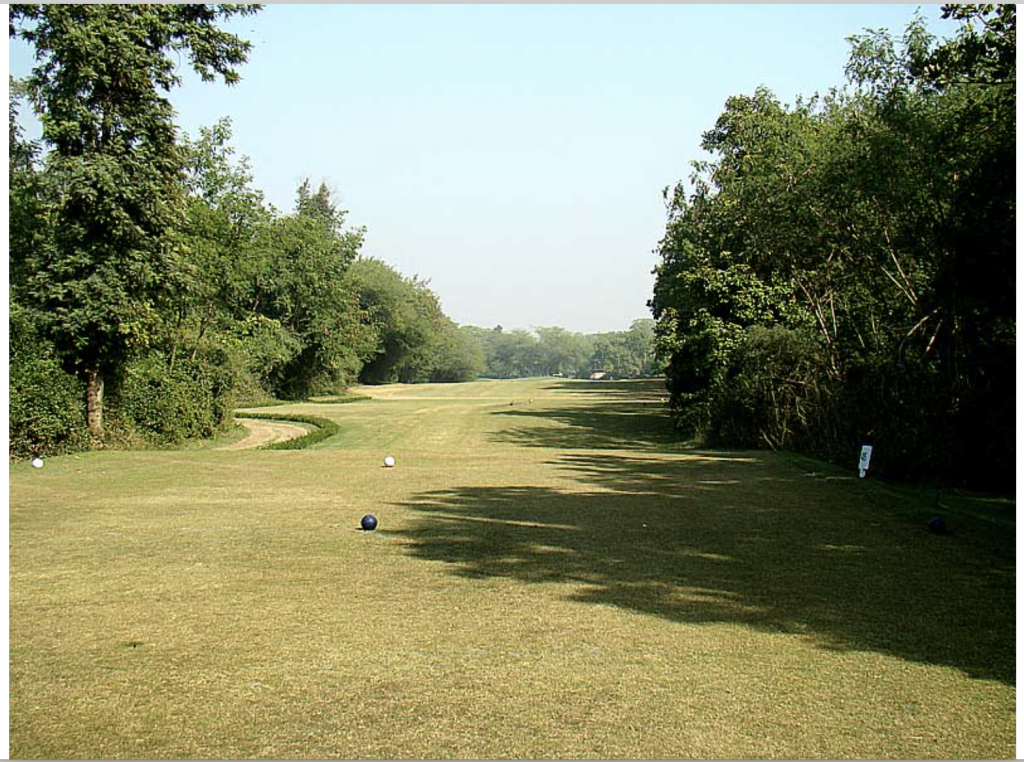
Delhi Golf Club, Hole #9
Hole 9 – Delhi Golf Club, India
Par: Four
Yardage: 445 yards
Hole scoring average: 4.38
Asian Tour events hosted: Hero Indian Open, Panasonic Open India
The ninth hole at the Delhi Golf Club requires precision and makes even the most confident drivers of the ball tremble, especially when a tournament is on the line. This hole has a reputation for being extremely unforgiving with a narrow fairway and thorn bushes on either side. The hole does not have any significant water hazards but the bunkers, unforgiving rough and mature tree line more than make up for that.
You can choose to use either a three wood or long iron off the tee in order to find the widest part of the fairway, or in this case, the least narrow! But the challenge with this strategy means it leaves a mid to long iron approach shot to an undulating, multi-tiered L-shaped green guarded by well positioned bunkers and thorn bushes. The braver folk will opt to use a driver, however any miscue will most certainly result in playing three from the tee.
“As a member over there, it is probably regarded as the hardest hole on the course even though it is not stroke index one – simply because it gives you a few options. It is long enough to tempt you to hit a driver off the tee but it really narrows in at about the 270 to 280 yard mark – the fairway becomes half its width. It is a perfect risk reward hole if you are willing to man up and take it on with a driver, which really makes your second shot a lot shorter into a green that is quite demanding because it is a raised green that falls off to the right. The typical Sunday pin there was back right over a bunker and if you laid back too far, if you hit a three wood or a two iron off the tee, it would leave you too long a shot to be able to access that flag in anyway.
I have seen a lot of big numbers there; I have seen a lot of people lose tournaments there in the past; and I personally have made some high numbers on that hole. When we play tournaments there, the prevailing wind is normally into the wind and coming off to the left so that makes it even more demanding. It is about 440 yards, but it plays closer to 460 or 470. You also have bushes down the sides, so visually it is a very intimidating hole. I think some of the hardest holes in golf are the ones that are straight and not actually dog-legs. About five years ago there used to be a tree in the middle of the fairway, on the left half of it – it fell down in a storm. When that tree was there it made it even more challenging because if you hit anything up the left half you didn’t have a clear shot – so it was even more demanding before.”
Shiv Kapur: a four-time Asian Tour winner, and former Asian Games Gold medallist.
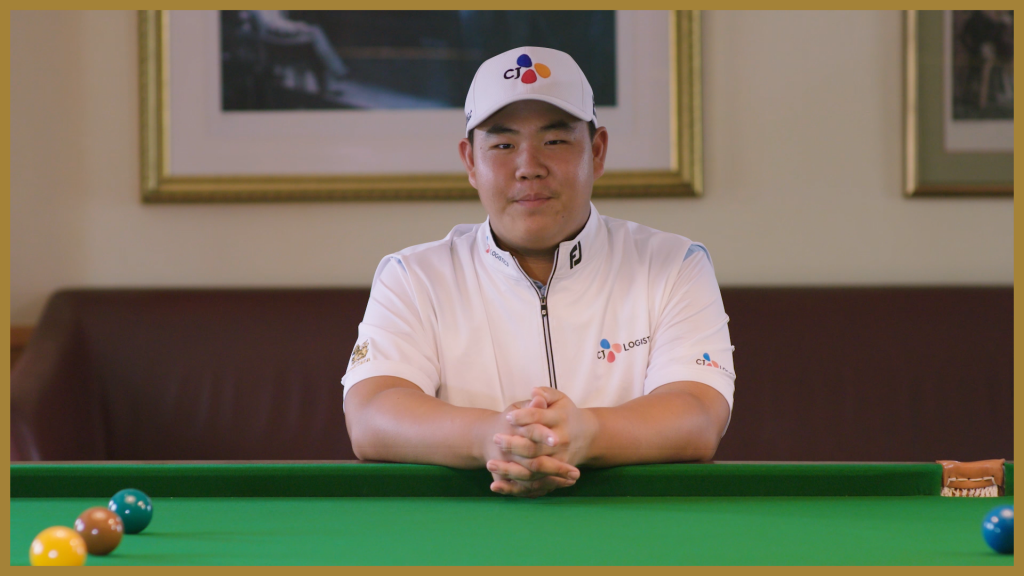
We caught up recently with Korea’s Joohyung Kim, who has been making a name for himself since joining the play-for-pay ranks in 2018. Find out more about the 18-year-old rising star in this latest feature. Kim will be making his regular PGA TOUR debut at the Safeway Open this week.
[embedyt] https://www.youtube.com/watch?v=_3wHmT2VlsM[/embedyt]
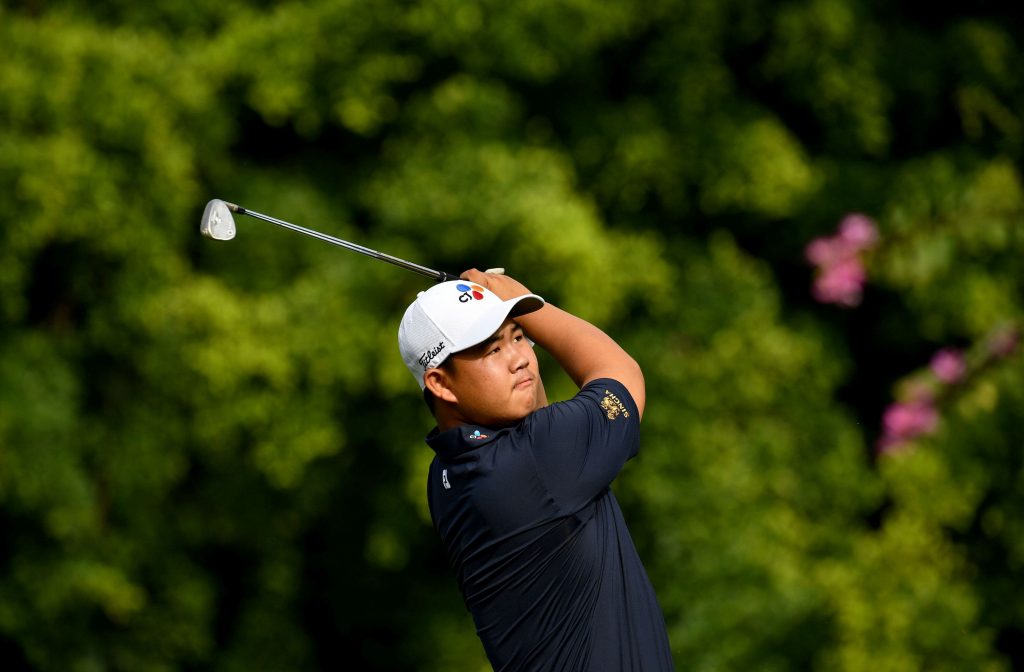
[embedyt] https://www.youtube.com/watch?v=_3wHmT2VlsM[/embedyt]
Korean wonder kid Joohyung Kim has revealed some of the keys to his early success prior to his regular PGA TOUR debut at this week’s Safeway Open – the opening event of the 2020/2021 season on the PGA TOUR.
And his father Changik Kim – a former Tour professional who played on the Buy.com Tour (now known as the Korn Ferry Tour) in the United States before becoming a teaching professional – has most definitely been the guiding force behind his meteoric rise.
“My dad didn’t teach me the basics first,” said the 18-year-old Kim.
“He made sure I just had fun. We always went to the golf club to eat, drive the cart and hit some putts. But as I started to take it really serious he always taught me to practice hard, swing mechanic wise.”
They were living in Australia when he first picked up a golf club aged five, or as he says: “a short baby club”. But it wasn’t until they moved to the Philippines, when he was aged 11, that he really started to take the game seriously.
“Basically, my parents taught me was always to practice hard and be humble. And I feel like that was the most important lesson of all. And always will be,” added the Korean.
Kim cleaned up on the amateur circuit in the Philippines – he won the 2017 Philippine Junior and the 2018 Philippine Amateur – before turning professional in 2018.
And since then he has established himself as one of the most exiting young players in the region with huge potential to be one of the dominant players in the game.

After earning a battlefield promotion from the Asian Development Tour by winning three events last season, the youngster made an instant impact by winning in just his third start on the Asian Tour at the Panasonic Open in India.
That made him the second youngest professional to win on the Asian Tour at 17 years and 149 days with countryman Seungyul Noh being the youngest when he won the 2008 Midea China Classic at the age of 17 years and 143 days.
Kim says his father, who is now 50 years old, is always on hand to offer advice.
“I ask him some stuff with golf because he is always with me and he knew my game ever since the beginning. So I feel like I can always go up to him and ask.
“My dad never plays. Doesn’t really have the time because he is always with me. But hopefully we can get a round one day. It would be fun to bring back the old memories. But he sometimes hits some chips and some putts, even hits one or two balls but nothing serious really.”
Kim also won on the Korean PGA Tour in July at the KPGA Gunsan Country Club Open – which was his first win on home soil and saw him become the youngest winner on that circuit at the age of 18.
It moved him inside top-100 on the Official World Golf Ranking (OWGR) and earned him a place in last month’s US PGA Championship – where he made his Major debut.

Despite his incredible success as a teenager, he is quick to downplay his achievements.
“I don’t think I have success at my age to be honest. I feel like I need to be better and I still lack so much,” he says.
“I’m fortunate to have some success yes, to break into the top 100 in the world, win once on the Asian Tour but I still have so many goals and feel like I need to accomplish so much more. So I don’t think I have success yet. And have so much to learn. I know I can play against the best.”
He adds: “I feel like it’s just really little by little that I need to sharpen. I’ve played against the top players in the world, so I know I deserve to be here. But I just need to be more consistent overall to get me to the top and get all aspects better.”
Travelling the world as a Tour professional will certainly not bother him after a globetrotting childhood.
He was born on the Jeju island in Korea, where they stayed for a few months. They lived in China for a few years, then Australia for seven years, followed by the Philippines for six years and Thailand for a year and a half.
“And now for the first time in my life Korea,” says Kim.
On his game plan for this week’s Safeway Open, Kim says: “This time not really focused on something. More of just feeling free. And one step at a time. And play my own game. If I can do that the rest will follow.”
Ends.

Photo credits: Sportfive
Few players have dominated one of Asia’s National Opens like Australian Adam Scott has with the Singapore Open.
He has lifted the trophy on three occasions in 2005, 2006 and 2010 – an impressive haul, surpassed only by Jumbo Ozaki’s five Japan Open victories and the four wins by Spaniard Miguel Angel Jimenez at the Hong Kong Open. Tommy Nakajima also won the Japan Open four times.
Scott has claimed the Singapore Open more times than anyone and his success was in synergy with the emergence of the prestigious event on The Serapong course at Sentosa Golf Club.
The tournament was not played from 2002 to 2004 before being relaunched in 2005 at Sentosa – where it has, so memorably, been played since.
So, Scott’s win in 2005 was the start of an exciting new chapter for the event while it was on this day 14 years ago that he successfully retained the tournament.
And what an exceptional win that was on an unprecedented Sunday.
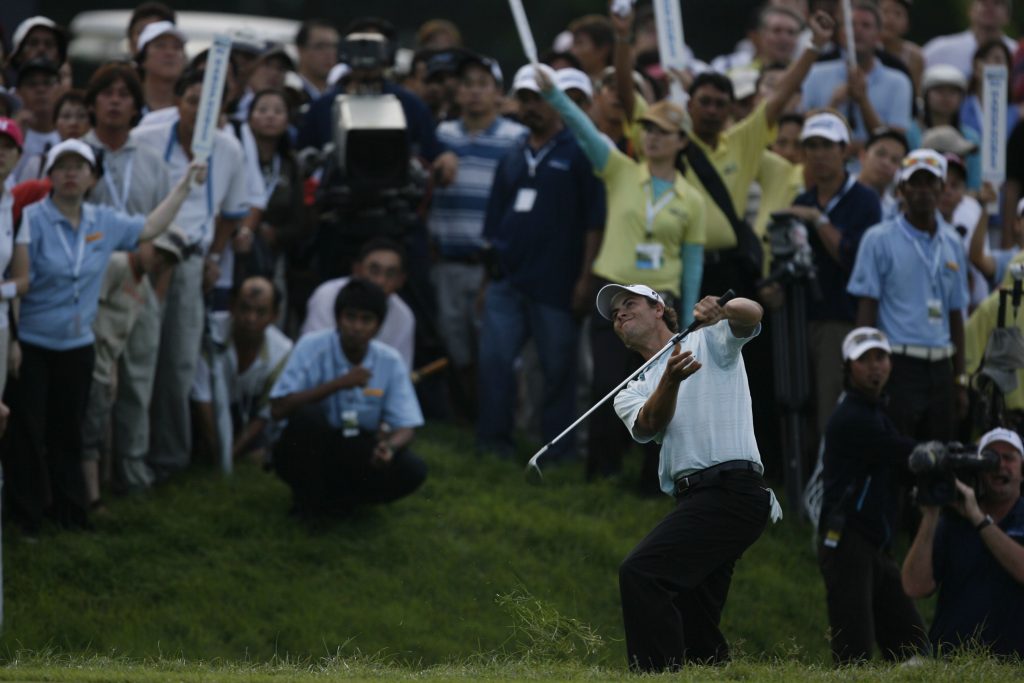
Adam Scott of Australia
The Australian, 26 years old at the time, beat South African Ernie Els by two shots in a three-hole play-off in the US$3 million event.
He delivered the knock-out blow with a birdie at the par-five 18th to edge Els, after both players parred the first two holes – the 16th and 17th.
It was the 11th professional victory, but his first in 2006.
He coolly dropped in a five-foot putt while Els three-putted for bogey.
The rather unusual play-off format was the result of the fourth round being cancelled late on Sunday afternoon following two weather suspensions.
Organisers decided to reduce the event to 54-holes based on the scores after Saturday’s third round.
Hence, with Scott and Els tied on eight-under-par 205 after the third day the option was taken to complete the tournament with a three-hole play-off – much to the delight of the thousands of fans who had patiently remained on site waiting for a resumption.
“It’s the first time I have defended a title and it’s a great feeling and something that I will cherish. Like I said last year, it’s a great feeling to win a national Open and I’m really thrilled. It’s been a long time coming this win, since last year and hopefully I can keep going from here,” said Scott, who won US$475,500.
The fans were treated to a thrilling duel between the top two stars who matched each other blow for blow in the final round and the play-off. Els missed a birdie chance from 10 feet on the first extra hole on 16 while Scott saved par from five feet.
After both parred the 17th, Scott, the then world number six, gained the advantage on the 18th after an exquisite chip which left him five feet from the pin while Els struggled after a wayward drive put him in the shin-high rough. After finding the front of the green with his third, the South African agonizingly three putted from 25-feet.
“There wasn’t much separating Ernie and myself and whether that was over 72 or 54, or 65 holes which we played, it came down to a play-off and fortunately I won. I definitely feel I’m the winner of the tournament,” said Scott.
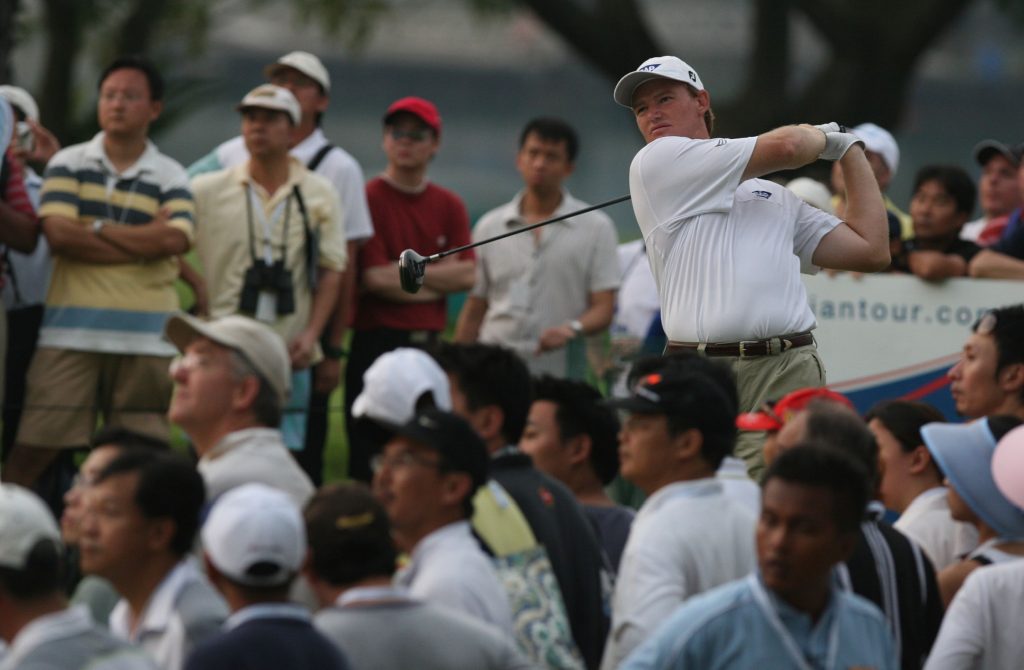
Ernie Els of South Africa
Els was naturally disappointed with the outcome. He said: “In the play off, I had my chances. I hit a good shot in to the 16th (to 10 feet) but did not hit the putt well. On 17 for some reason my tee shot came back – I was close to the hole but could not putt it.
“On the 18th I drove it right – just one of those things. On the third shot I was a club short, it was coming nicely on line but unfortunately it was not enough club. It is disappointing,” added the South African.
Australian Brad Kennedy took third place with his three-round total of 208 while China’s Liang Wen-chong settled for fourth position on 209.
The tournament had started with Filipino rookie Juvic Pagunsan and Scott Strange of Australia sharing the first round lead shooting four-under-par 67s.
However, on day two Els made his move surging up the leader board firing an imperious 65 – a course record at the time – to take a share of the lead with Strange.
Titleholder Scott then set up a mouth-watering showdown with Els after a 66 on Saturday. Els needed an injection to treat a bout of food poisoning during a two-hour weather disruption but he battled on gamely to finish the day tied at the top.
As expected the final round was a tight affair but a one hour and 40 minute delay in the morning due to lightning, and another torrential thunderstorm late in the afternoon, meant they could only complete eight holes before the fourth day was abandoned and the crowds eagerly gathered to watch the play off.
The tight finish was in stark contrast to Scott’s victory the year before when he sauntered to a seven stroke win over England’s Lee Westwood – that result happened this Friday, a mere 15 years ago.
Ends.

David Lipsky, the Asian Tour Order of Merit champion in 2014, hit the headlines very recently by winning the TPC San Antonio Challenge on the Korn Ferry Tour in July.
Interestingly, the American went to La Canada High School in Los Angeles – where his countryman Collin Morikawa, currently the hottest player in the game, also attended.
And Lipsky’s Korn Ferry Tour win, which was his first, came less than one hour after Morikawa earned his second success on the PGA TOUR at the Workday Charity Open.
It is evidence of the calibre of Lipsky – who also attended the prestigious Northwestern University in Chicago, where, amongst other, England’s Luke Donald enjoyed an outstanding college career.
To date, Lipsky has also claimed two titles both on the Asian Tour and on the European Tour.
And there is no doubt the biggest victory of his career so far came on this day six years ago in the Swiss Alps.
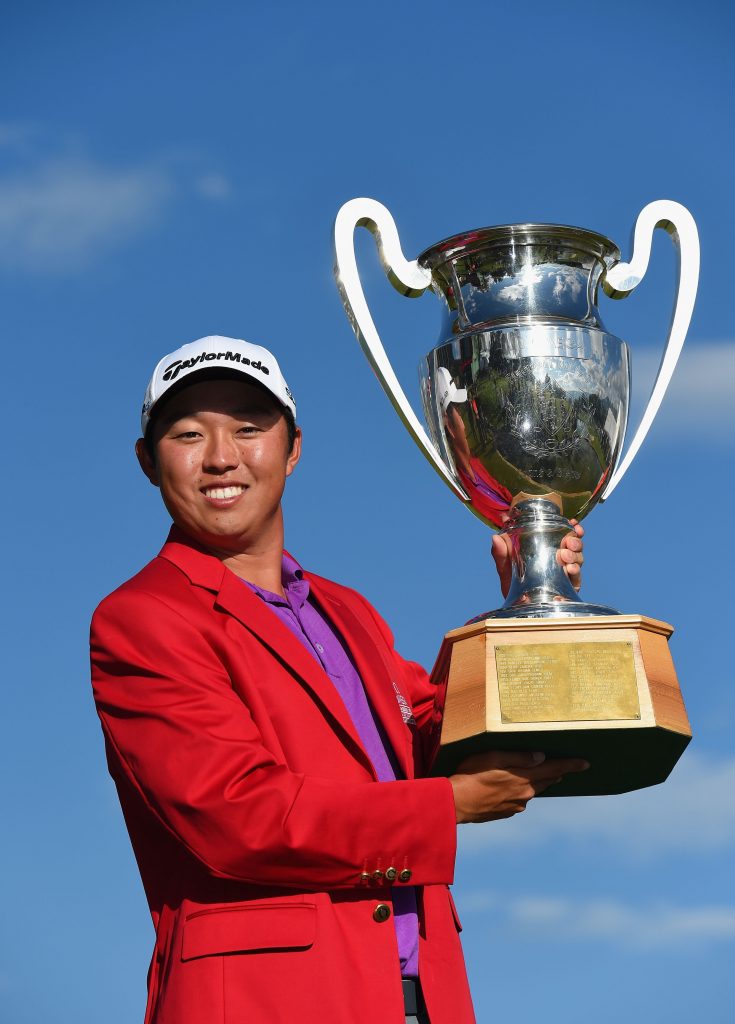
CRANS-MONTANA, SWITZERLAND – SEPTEMBER 07: David Lipsky of USA holds the winners trophy after winning in a playoff against Graeme Storm of England during the final round of the Omega European Masters at Crans-sur-Sierre Golf Club on September 7, 2014 in Crans-Montana, Switzerland. (Photo by Stuart Franklin/Getty Images)
In what was only his 18th start on the European Tour, he defeated Englishman Graeme Storm on the first hole of a sudden-death play at the Omega European Masters at Crans-sur-Sierre – an event steeped in history, with its origins dating back to the early 1920s when it was the Swiss Open.
Lipsky was 26 years old at the time and had only been a professional for three years but showed maturity beyond his years in the way he played the play-off hole.
He had started the final round two shots behind overnight leader Storm but, playing in the penultimate group, he charged through with a five-under-par 65 to set the clubhouse lead on 18 under.
That was helped by a birdie on the par-four 18th – where he hit his approach to within inches of the cup – and meant Storm needed a par there to force the tournament into overtime.
The Englishman duly made four meaning he and Lipsky finished one shot ahead of none other than emerging American star Brooks Koepka, who was tied for the lead until a bogey on the 17th, where his wayward approach plugged in a greenside bunker.
When they returned to 18 for the play-off, Lipsky played the hole very differently after his opponent hit a poor tee shot that missed the fairway and came to rest against a wall.
Storm had no option but to chip out on to the fairway.
Lipsky, who had just 86 yards to the hole from a bunker with his second shot, took no risks and laid up short of the green.
It proved to be the right decision as after he chipped close to the pin, Storm made a five, and he was left with a simple putt for victory.

CRANS-MONTANA, SWITZERLAND – SEPTEMBER 07: David Lipsky of USA celebrates winning in a playoff against Graeme Storm of England during the final round of the Omega European Masters at Crans-sur-Sierre Golf Club on September 7, 2014 in Crans-Montana, Switzerland. (Photo by Stuart Franklin/Getty Images)
Speaking about the play-off hole, Lipsky said: “It’s a tough tee shot anyway, but when there’s the title on the line it’s very tough.
“You have to draw your tee shot from right to left to hold it against the hill, and I thought I’d hit a great shot but it ended up going in the bunker.
“It was a tough shot out of the bunker and, with Graeme only going to make par at best, I decided not to risk going in the water. In the end it was the right play, and I’m so pleased to get the job done.”
Storm reflected: “It’s tough to take right now. I didn’t have much time between finishing my final round and starting the play-off, so I probably wasn’t as composed as I should’ve been.
“So it was obviously disappointing, but overall it’s been an unbelievable week. There is a lot of emotions flying round right now so I’ll have to reflect with a clear head in the morning, but there are definitely lots of positives to take from the week.”
Lipsky earned €383,330 for his triumph, putting the wheels in motion for claiming the Asian Tour Order of Merit title later in the year.

CRANS-MONTANA, SWITZERLAND – SEPTEMBER 07: David Lipsky of USA plays a shot during the final round of the Omega European Masters at Crans-sur-Sierre Golf Club on September 7, 2014 in Crans-Montana, Switzerland. (Photo by Stuart Franklin/Getty Images)
He became the first Asian Tour member to win the Omega European Masters since this event became part of the Tour in 2008.
And he was the first American to win the Omega European Masters since Craig Stadler in 1985.
Lipsky’s journey on the Asian Tour began when he won the Qualifying School in January of 2012. And, he was victorious in the Handa Faldo Cambodian Classic just two months later before a sensational 2014 thrust him into the international spotlight.
Two years ago he also claimed the Alfred Dunhill Championship in South Africa for his second win on the European Tour.
With European, Asian and Korn Ferry Tour wins to his name, he is building a mightily impressive portfolio of tournament wins across the globe.
But producing a more impressive victory than the Omega European Masters will take some doing.
Ends.

Anthony Kang: Fate, Funky Music and the Badlands (Part 2)
By - Serene Loh
[addtoany]

In the second and final part of our feature on three-time Asian Tour winner Anthony Kang, the American talks about his famous victory at the Maybank Malaysian Open, swing fundamentals and his transition into TV land.
In the second and final part of our feature on three-time Asian Tour winner Anthony Kang, the American talks about his famous victory at the Maybank Malaysian Open, swing fundamentals and his transition into TV land.

KUALA LUMPUR, MALAYSIA – FEBRUARY 15: Anthony Kang of USA poses with the trophy after winning the Final round of the 2009 Maybank Malaysian Open at Saujana Golf and Country Club on February 15, 2009 in Kuala Lumpur, Malaysia. (Photo by Ian Walton/Getty Images)
While Anthony Kang always looks back on his victory at Casino Filipino Philippine Open in 1999 as one of the great highlights of his career – because it was his maiden win – his triumph in Malaysia’s National Open 10 years later carries as much significance to him, and perhaps even more.
It is the manner of that win, which came down to a nail-biting finish, which is so important to him.
“At the Maybank Malaysian Open having a chance to hit my second shot on the par-five final hole of the tournament, the 72nd hole, and knowing if I pulled the shot off I was going to win the tournament was an incredible moment and experience.
“To me it is a rare occasion in golf to be in a position to hit that winning shot when the time is ticking off – it happens in other sports like American football, even soccer, or basketball or baseball. So I felt like it was that moment for me and to experience a moment like that, which all great players have – like Tiger Woods, Rory McIlroy and Dustin Johnson – I feel fortunate that at least in Malaysia that tournament provided me the opportunity to experience that moment and then fortunately to come out ahead on the right side of it.”
He birdied the 18th at Saujana Golf and Country Club to win by one from four players: England’s David Horsey and Miles Tunnicliff, Thailand’s Prayad Marksaeng and India’s Jyoti Randhawa.
It ended an eight-year title drought and as the event was jointly-sanctioned with the European Tour it secured him playing privileges there.
“As soon as I won, I called my brother and said do you want to come and caddie for me in Europe, because we are going to make millions!” said the American.

KUALA LUMPUR, MALAYSIA – FEBRUARY 15: Anthony Kang of USA in action during the Final round of the 2009 Maybank Malaysian Open at Saujana Golf and Country Club on February 15, 2009 in Kuala Lumpur, Malaysia. (Photo by Ian Walton/Getty Images)
He quickly points out that that did not come true but that the opportunity was the most important element.
He adds that his game was gathering momentum in the lead-up to Malaysia: “Before Malaysia, about two years prior to, I was playing pretty solid golf. I wasn’t hitting any wild shots. I was very consistent, week after week, and I was making putts. While I wasn’t contending very much, I still had a lot of top 10 to 20 finishes. I was loving it. I’d show up, play, make some money and sometimes have a chance to win. Week after week after week, everything was in the positive.”
Unfortunately, success at Saujana did not open the floodgates to more firsts. In fact, quite the opposite happened.
“My game started to go about one month after the Malaysian Open,” says Kang.
He remembers playing a practice tournament at the Ballantines Championship in Korea on Jeju Island with Ted Oh, Unho Park and Lam Chih Bing (his regular practice group) when things started to go wrong.
“On the eighth hole I hit this drive and it went six yards right and I couldn’t figure out why that shot happened and ever since that happened my game started to slowly erode. So every day after that I was trying to fix it – it was like that story of the kid in Amsterdam who is trying to plug the dam wall by plugging the leaks day after day.”
He feels it was his fundamentals and technique that let him down.
“My fundamentals were not very solid. I had a band aid week after week to make the ball go straighter. I was thinking if the ball went straight, whatever I was doing, that’s correct. As opposed to looking at the proper technique, proper sequence, proper timing.
“Back then the information was not available, the technology wasn’t there, the data wasn’t there, to say the swing has to be sequenced this way, the hips have to move this way – it was more trial and error. Back then it was legendary stories of Vijay Singh.
“That was the mentality I had. I needed to see the ball on the driving range going straight, didn’t matter what my swing felt or looked like.
“I think in the end having the lack of knowledge caught up to me.”

KUALA LUMPUR, MALAYSIA – FEBRUARY 15: Anthony Kang of USA celebrates after winning the Final round of the 2009 Maybank Malaysian Open at Saujana Golf and Country Club on February 15, 2009 in Kuala Lumpur, Malaysia. (Photo by Ian Walton/Getty Images)
Kang jokes that it was missing cuts that led to opportunities working in television commentary but in the ensuing years he still went on to become one of the most successful players on the Asian Tour with over US$2 million in career earnings. He currently sits in 22nd position on the Career Earnings list.
He first got into commentary at the Indonesian Open in 2014, where Dominique Boulet – a key member of Asian Tour Media broadcast team – suggested he turn his hand to some on course commentary.
“I had just missed another cut and it was a televised event and Dom came into the clubhouse and he sat down with us and asked me if I wanted to go on the golf course tomorrow and do on-course commentary. And I looked at him and I thought that might be fun. Let me give it a go,” says Kang.
“I still find it extremely difficult. It is really difficult. But it was especially in the beginning. I remember that first time in Indonesia in the morning when I arrived, I looked at the amount of people who were there and the amount of equipment. It was all foreign to me, I had never seen anything like it. And my first thought was I don’t want to be the one guy who messes this up for everybody. The first time is what like I was a soldier and I had never had any weapons training and they gave me a rifle and told me to go out there and do your thing.”
Kang was on our television screens in September working for FOX Sports covering the US Open.
“I still get very nervous before the show starts, especially the five minutes before the show starts, and probably about five to 10 minutes into it. But once you get through that you start to get into the flow of things and relax. When they say it’s going to go live it gets your nervous energy up,” he says.
“It is a lot of hard work. You do a lot more than show up and answer questions. You have to do your prep work. You have to make sure you are prepared and that you have something relevant and then on top of it you have to follow the structure of the programme.”
Kang turns 48 in November and fully intends to play the senior circuit in two years time.
He will be exempt on the European Seniors Tour (now called the Legends Tour) thanks to his win in Malaysia and says: “I am going to give that a go because through that Tour there is a very, very small window that can lead you onto the Champions Tour in the US. It is a very small window. But because of that I am going to give it a go.”
He has come a long way since growing up in Seoul before emigrating with his family to Hawaii when aged 10, in 1982 – which is when he started playing golf.
“Nobody taught us, we just went out with my Dad and Mum and played. They just thought it would be a good idea for the family to spend time at the weekend,” he says.
He picked up the game like a natural and by 1990 a couple of colleges offered him a golf scholarship but he settled on Oregon States University.
Said Kang: “I thought Oregon would be better for my golf career.”
An understatement if ever there was one and probably the most important ‘club’ selection of his career.

Thai legend Thongchai Jaidee talks about his time on the Asian and European Tours, breaking down barriers and being a role model for young Thai golfers.
Thongchai Jaidee talks about his time on the Asian Tour and European Tour, breaking down barriers and being a role model for young Thai golfers. My Time is a documentary series in partnership with Rolex going in-depth into Asian Tour players careers.
Thai legend Thongchai hopes to inspire next generation – “In the future I really want to see the young Thai and Asian players perform better than Thongchai Jaidee. I want them to see that I started from nothing but I managed to get where I am today. I want to be their role model.”
[embedyt] https://www.youtube.com/watch?v=BoAFifWy6dE[/embedyt]
Read more about Thongchai’s illustrious career here.

Imagine a golf course consisting of the most iconic and challenging holes on the Asian Tour.
Imagine a golf course consisting of the most iconic and challenging holes on the Asian Tour.
A fictional hybrid-layout that features one of the region’s standout opening holes, one of the finest second holes and goes all the way through to an epic 18th.
A layout that would be the ultimate challenge – where breaking par is a monumental achievement.
Well, just such a virtual course now exists, as an Asian Tour panel of experts has selected the appropriate holes to make up what is the golf course of all golf courses in Asia.
With a par of 70 and length of 7,430 yards, we have appropriately named it The Asian Tour Monster.

To navigate us through The Asian Tour Monster, we asked players and experts to describe each hole – all of which have played key roles in many of the biggest tournaments on the Asian Tour.
Let us know what your think on our social media channels – Facebook, Instagram, Twitter.
Feature: The Asian Tour Monster – Front nine

Taiwan Golf and Country Club
Hole 10 – Taiwan Golf and Country Club
Par: Three
Yardage: 221 yards
Hole scoring average: 3.36
Asian Tour event hosted: Mercuries Taiwan Masters
Hsieh Min-nan, who is one of the true legends of golf in Chinese Taipei, describes this hole as one of the most difficult par-three holes in the world. Considering his lofty standards, this hole is definitely worth including as one of the most difficult on the Asian Tour.
It has a smallish green but it looks tiny when you are standing over 220 yards away, with howling winds holding on to a three-iron or hybrid. You will end up in a deep bunker or a penalty area if you are too far to the left, while a gaping bunker guards the right side of this narrow table-top green, adding to the challenge of this beautiful beast of a hole.
Once you reach the green, you face a putting challenge like no other – the greens at Taiwan Golf and Country Club are renowned for confusing even the best of putters. It is worth noting that during the 2018 Mercuries Taiwan Masters, only seven birdies out of 349 attempts were made on this hole.
“In my opinion it’s the hardest par-three green to hit on the Asian Tour, and maybe in the world! I think I’ve only ever hit the green two times. Most of the time I’m playing to miss the green short because that green is so difficult to hold with a four iron. You can get it up and down from the front part of the green. The best shot I have ever seen on that hole was when I watched one of the Taiwan legends a couple years ago pull out driver and hit this high cut to like 20 feet. It was the best shot I’ve ever seen there. Every time I walk off that green with a par I feel like I’ve made birdie!”
Berry Henson: a winner on both the Asian Tour and Asian Development Tour, who was runner-up in the Mercuries Taiwan Masters in 2018.

Black Mountain Golf Club
Hole 11 – Black Mountain Golf Club
Par: Three
Yardage: 191 yards
Hole scoring average: 3.2
Asian Tour events hosted: Black Mountain Masters, Thailand Classic, King’s Cup, Royal Trophy
This intimidating downhill par-three is the signature hole at Black Mountain Golf Club. It has a narrow double-tiered green, with two-thirds of it surrounded by water. A wall of trees protects the bail out area on the left, ready to deflect any shots hit in this direction back into the water.
According to two-time Asian Tour winner Rikard Karlberg and resident professional, who is also a Black Mountain club member, he says: “Never think about the water as you can lose shots very easily. You just have to aim and hit it straight to the middle of the green and hope for the best”.
“The 11th hole, the signature hole at Black Mountain, has the Black Mountain hill as its back drop. It is a tough green to hit, especially when the wind is blowing.
There is a feeling the green is an island green – even though it is not.
There is no real bail out on this par three as there is water just right of the green and if you were to pull the shot slightly left then there are over hanging trees and a stream where the ball is most likely to end up. The hole certainly is a challenge and if you walk off with par then most people will be happy.”
Simon Yates: is a two-time winner on the Asian Tour and resident at Black Mountain.

Hole 12 – Macau Golf and Country Club
Par: Five
Yardage: 571 yards
Hole scoring average: 5.2
Asian Tour event hosted: Macau Open
This hole demands astute ball control. Being a mountainous course, it can get very challenging with the wind constantly changing directions due to the many ridges and valleys that intersperse the property.
Firstly, a well struck drive is needed to avoid the troublesome fairway bunkers and to carry the ball over water. An accurate second shot is then required to avoid the bunkers guarding the lay-up area and penalty area on the left of this par five, which stretches and rises across the irregular terrain. This sets you up for a mid to short iron approach shot to a severely sloping two-tier green. Being on the correct tier with your approach shot here is paramount as this green has yielded more than its fair share of four-putts.
India’s Anirban Lahiri birdied this hole in the final round of the 2016 Venetian Macao Open – which was the first of an incredible run of seven birdies to force a play-off with Thailand’s Pavit Tangkamolprasert. Pavit eventually prevailed for this first win on the Asian Tour.
“On that final Sunday [in 2016], I used a driver for my first shot on hole 12. This hole is a long par-five – no one can really reach in two. On the second shot I used a hybrid – you just really need to get it on the fairway. Third shot I had about 100 yards left, so I used a 56-degree wedge which I pitched left of the flag and then made about a six yard putt for birdie. The hole is not as tough as 13, but the green [on hole 12] is very tough, especially if the pin is on the back as there is a huge slope.”
Pavit Tangkamolprasert – a two-time champion on the Asian Tour, and winner of the 2016 Venetian Macao Open.

Hole 13 – TPC Kuala Lumpur (West course), Malaysia
Par: Four
Yardage: 459 yards
Hole scoring average: 4.38
Asian Tour event hosted: Malaysian Open
You will need both length and accuracy with your tee shot to play this hole – which is a lengthy uphill hole. A penalty area on the right and thick rough up the left side await wayward drives. A solid mid to long iron is then required to reach the elevated green. The right side of the green is preferred as deep bunkers guard the left side of the long and narrow green. Club selection will be important as the green has three tiers and any mis-clubbed approach shot can result in possibly having to negotiate some lengthy winding putts. Downhill putts will be especially challenging.
“I hit driver off the tee here, making sure I start my ball on the left side of the fairway. On this hole, the one place you don’t want to go is right. I try and hit a little fade as well. Most important is to keep it on the fairway. The toughest part of the hole is the second shot. There is a very high elevation, maybe about seven or eight metres up hill. I normally have a six iron in. I try to hit a draw as, if anything, you want to miss on the right side of that hole. If I walk away with par I will be very happy. So far I have played this hole well in tournaments, with a couple of birdies.”
Danny Chia: a two-time winner on the Asian Tour and four-time champion on the Asian Development Tour.

NEW DELHI, INDIA – MARCH 29: David Law of Scotland tees off the 14th hole during round two of the Hero Indian Open at the DLF Golf & Country Club on March 29, 2019 in New Delhi, India. (Photo by Ross Kinnaird/Getty Images)
Hole 14 – DLF Golf and Country Club, India
Par: Four
Yardage: 535 yards
Hole scoring average: 4.53
Asian Tour events hosted: Hero Indian Open, Avantha Masters, Johnnie Walker Classic
The 14th hole at the Gary Player-designed DLF Golf and Country Club is just a ruthless golf hole. Long is an understatement when describing this par-four which demands two massive and precise shots to reach the green. Adding to the challenge is the forced 250-yard carry off the tee over dense scrub that runs down the entire left side. Once you have the green in your sights, you will be faced with a downhill lie and needing at least a long iron to reach an elevated green with steep fall offs on either side.
It is a hole that probably cost American Julian Suri the Hero Indian Open title last year. Suri had a three-shot lead with six holes to play but made a quadruple-bogey eight, after taking six shots to get down from just off the green. He eventually had to settle for a share of fourth place.
“Normally when we play this hole, it is a par-four, otherwise for the club members it is a par-five. My personal view about that hole is that it is the toughest hole on the golf course and one of the hardest in the region. Firstly, for your tee shot you can’t hit a driver, some people do, because it is very narrow and there are some rocks placed beautifully on the right side of the fairway. Then you need to use anything from a rescue to a three-wood to a three iron depending on where your ball ends up, to a green that is a very narrow. You also come in from an angle – the green is basically towards the left side when you are standing in the middle of the fairway. Plus there is a huge swale before the green and on the right hand side of the green. And the green slopes left to right towards the swale. So it is difficult to stop the ball on the green unless you hit a high ball. Even if you try and hit a low shot and run it up you have to hit it way left because the green is all left to right and you have to have a perfect bounce.
If you go into the swale on the right … well the swale is at least 15 feet deep. During the tournament 80% of the golf balls end up there, even though players think their ball is on the green but everything slopes into the swale – where there are a lot of pitch marks. You want to make sure you hit a high lofted second shot onto the green, so it stays on the green. Some people try and take it left of the green but then what happens is it takes a big bounce and goes to the left hand side and you are left with a downhill chip and from there most of the time people chip it over into the swale on the right. Management is very important. A par on that hole is a bonus and you want to make the most of it and if you try and get too smart just try and make a bogey and move onto the next hole. I have never made a birdie there in tournaments, made a double once but normally pars or bogies.”
Jeev Milkha Singh: a two-time Asian Tour Order of Merit champion, and five-time winner on the Asian Tour. He has also claimed four titles in both Europe and Japan.

Hole 15 – The Serapong, Sentosa Golf Club, Singapore
Par: Four
Yardage: 429 yards
Hole scoring average: 4.20
Asian Tour event hosted: SMBC Singapore Open
A very intimidating par-four and one that enhances Serapong’s reputation as a true championship layout. The fairway is extremely narrow with a sea channel running all the way down the left side of the hole, where a countless number of balls have found a watery grave. It is also a long par-four that requires full concentration.
“The 15th is a really good hole. Visually intimidating off the tee, it is probably the most difficult tee-shot on Serapong, after the third hole.
I usually aim at the second bunker on the right with a three wood and play a draw. The reason for a draw is that in the worst case if you overdraw it and it ends up in the water you can at least drop the ball up in the fairway and still have a shot at the green. I have seen many players pull it straight left into the sea and have to drop the ball very near from the tee box … it’ll almost always be an automatic double when that happens.
If you are able to hit the fairway, I would say the hole becomes straight forward from there, but I have seen a lot of bail outs to the right.
If you are in the right rough, the second shot becomes tricky as you have to contend with the trees to carry for your approach.
A back left pin is the most difficult pin position on this hole. When the pin is there, we usually just aim for the middle of the green… if not you’d have to contend with the bunker and also water if you go long and left.
The majority of players will a hit fairway wood off this tee, however, there was one round when I played with Phil Mickelson and he pulled out a driver, hit it about 30 yards right of the fairway into the trees, but he was able to hit a really high shot over the trees and get away with par.”
Lam Chih Bing: a winner of 10 titles in the region including one victory on the Asian Tour at the Volvo Masters of Asia in 2008.

Hole 16 – Namseoul Country Club, Seoul, Korea
Par: Four
Yardage: 533 yards
Hole scoring average: 4.75
Asian Tour event hosted: GS Caltex Maekyung Open
The 16th hole is a straight and long downhill par-four with OB all the way down the right. It requires precision off the tee to a narrow fairway guarded by bunkers on the left and at the end of the landing area. A long iron or hybrid will be needed for your approach shot, however the downhill lie will hinder your efforts at keeping the ball on this green. Bunkers short and over the green are always in play with the OB once again in play down the right.
Prior to the 2017 edition of the GS Caltex Maekyung Open, this hole was played as a par-five for the tournament. After changing to a par-four, it has since become the toughest hole of the tournament for the last three years.
“Nam Seoul’s 16th hole is the hardest hole on the course. On the tee I usually hit five-wood or hybrid depending what club I use for that week. You want to hit something around 260 yards so you are just short of the fairway bunker and not too far from the hole.
I usually have about 200 to 215 for my second depending on how well I strike it. Most of the time I will use a five iron to this green. This hole is so hard because you will have to hit your second shot from a downhill slope, which it makes it so hard to stop the ball on the green, and there are two deep bunkers around the green. This hole is so hard that when I make par on this hole I feel like I made a birdie. One interesting story that I have involves the first round from last year. I had an afternoon tee time and I was playing well and I believe I was leading the tournament at that time, until the 16th hole. I don’t know what happened but I ended up making a quadruple bogey and everything went south from that point…”
Yikeun Chang: winner of the 2019 Yeangder TPC and the 2016 Qualifying School. He was also runner-up at the GS Caltex Maekyung Open in 2018.

Hole 17 – Royale Jakarta Golf Club, Indonesia
Par: Four
Yardage: 459 yards
Hole scoring average: 4.29
Asian Tour event hosted: BNI Indonesian Masters
The 17th hole is a lengthy par-four at Royale Jakarta Golf Club. To master this challenging hole, you need to execute a well-struck tee shot to a less than generous fairway. A penalty area that runs all the way down the right and thick rough down the left will definitely test your nerves. And depending on the wind direction and quality of your tee shot, the approach shot can be with anything from a short-iron to a long-iron, to an undulating green that is guarded by a bunker on the left and water short and to the right of the green.
“That is a great hole, it is definitely one of the most challenging holes, especially for the 17th hole of a golf tournament. For the longest time, I have always played that hole hitting three wood over the little bunker in the middle there because to me it’s the widest part of that fairway, although it is not very wide to begin with. Once you get up to 290 to 300 yards that’s where the fairway gets narrower. Typically the rough has always been thick at Royale Jakarta but the last few years it hasn’t been so, so it’s been manageable. Teddy [Teddy Harmidy his friend, and caddie at the 2019 BNI Indonesian Masters] had me try and hit driver there when we were preparing for the tournament, a few months before. He said if I am going to caddie for you I want you to try this. So I did that and hit it out there and once I saw where my ball ended up, even if it wasn’t in the fairway, I realized I am only hitting a nine iron at most into the green. Normally with a three wood off the tee I am hitting maybe a six, seven or eight iron into the green. So it’s been an ongoing debate, what’s more important? Hitting in the fairway or long. So I started to change my mind set. And I started to realize I do hit it quite far so I should take advantage of that on some of these longer holes, even if you are going to be in the rough. The green slopes left to right and so anything left of that green is dead. Where they put the pins there is quite challenging. I actually bogeyed it the first two days last year and birdied it the third round and parred on the last day. You need to hit a good second shot with that green. There are not many flat spots on the green, maybe one. A par on the hole is very good.”
Danny Masrin: a seven-time winner on the PGA Tour of Indonesia, who finished equal fifth in the 2019 BNI Indonesian Masters.

HONG KONG- The Hong Kong Open at the Fanling Golf Club, Fanling, Hong Kong, the Asian Tour USD$ 1 million event is the season opener. Picture by Paul Lakatos / Asian Tour.
Hole 18 – Composite Course, Hong Kong Golf Club
Par: Four
Yardage: 410 yards
Hole scoring average: 4.281
Asian Tour events hosted: Hong Kong Open, Alfred Dunhill Masters, Johnnie Walker Classic
Known as “The Ultimate”, this is the closing hole on the Eden Course at the Hong Kong Golf Club and also the final hole of the Composite Course – a famous layout consisting of the best holes of the Eden and New Courses, specifically configured for the Hong Kong Open.
It is a hole deeply ingrained in the rich history of Asian golf, and viewed as one of the great amphitheatres of tournament golf globally.
Though not a long par-four, by modern-day standards, it demands the utmost respect, and requires the fullest care and consideration.
The hole’s statistics at this year’s Hong Kong Open, tell a familiar story: measuring 410 yards, it was ranked the second hardest with an average score of 4.281; there were just 40 birdies, 215 pars, 101 bogeys, 19 double-bogeys and two “others”.
Off the tee, most players will favour a long iron to the widest part of the fairway on the left. However, if you are brave enough, you can choose to go with a three-wood or driver and attempt to thread the ball through the narrowest part of the fairway to set up an easier approach shot. With trees and OB threatening on the left and a dense cluster of trees and bunker to the right of the fairway, it is risk verses reward.
Having chosen your strategy and, hopefully, successfully executed it, it is time to take on the green. Although the elevated green is large, it is severely sloped from back to front, so it is always preferred to be putting from below the hole. There is a large lake in front of the green with bunkers the front and right. And any shot missed left will leave you in gnarly rough with a slim chance to get up and down.
It has been the setting for a wealth of gripping and well-documented drama over the decades.
Who can ever forget the heroics of Lin Wen-tang’s memorable play-off victory over Francesco Molinari and Rory McIlroy at the Hong Kong Open in 2008. Lin produced one of the finest shots ever seen on the 18th: after hooking his tee shot, he played a spectacular approach out of trees, over water, and a bunker, to within inches of the pin.
And, in 2011, McIlroy recorded his maiden triumph at the Hong Kong Open in remarkable fashion when he holed out from a greenside bunker at the last to finish two shots clear of France’s Gregory Havret.
“I usually hit three-wood these days, try to hit a fade off the trees on the left but usually end up in the trees! At the Hong Kong Open in 1996, I hit a two-iron off the tee and then an eight-iron to about 12-feet. I made the birdie putt to finish fourth.
In the 1996 Alfred Dunhill Masters I holed a bunker shot from the right bunker for birdie to finish T11, I think. There were massive crowds that year. Langer, Els, Ballesteros and Monty were all playing. There must have been 20,000 people there that day.”
Dominique Boulet: a former Asian Tour player and Hong Kong number one. Now a highly respected television commentator and long-time member of the Hong Kong Golf Club.

Kota Permai Golf & Country Club, the tournament’s venue, has been the proud host of events on the Asian Tour since first staging the Volvo Masters of Malaysia in 1998 – the year the club opened.
When American rookie Trevor Simsby holed a four-foot birdie putt to beat Andrew Dodt, from Australia, in a sudden-death play-off at the Bandar Malaysian Open in March, it not only sealed his first win on Tour but the occasion also helped cement an important relationship that has lasted over two decades.
Kota Permai Golf & Country Club, the tournament’s venue, has been the proud host of events on the Asian Tour since first staging the Volvo Masters of Malaysia in 1998 – the year the club opened.
And over the past 22 years it has staged a wealth of Tour events, including: two Malaysian Opens, the Selangor Worldwide Masters twice, six Volvo Masters and a pair of World Cup Qualifiers.
It has been a special venue on Tour ‒ something that Thailand’s Thaworn Wiratchant will agree with having won the 2001 Volvo Masters of Malaysia and Selangor Worldwide Masters in 2012 on Kota Permai’s pristine playing surfaces.

Hole No. 2 at Kota Permai GCC
Many will also remember American Kevin Na ‒ aged just 19-years-old ‒ winning the Volvo Masters of Asia at Kota Permai in 2002, before departing on a highly successful and lucrative career on the PGA Tour.
In August, the popular Kuala Lumpur venue took another exciting step forward with its’ Tour association by becoming part of Asian Tour Destinations – an exclusive network of world-class golf venues, with direct ties to the Tour.
The other current Destinations venues include: Sentosa Golf Club in Singapore, Black Mountain Golf Club in Hua Hin, Thailand, and the Classic Golf & Country Club in New Delhi, India. Additional world-class Destinations will be added to the network over the coming months.
The Asian Tour Destinations brand offers a wide range of benefits to its members and the Tour, helping them to achieve their commercial and strategic goals.
It provides an affiliate membership programme between the associated venues – which have a collective membership base of 7,500 golfers.
Also, being a part of the network means that each venue is certified Tour calibre and operates a comprehensive range of facilities and services to their members and guests under tournament-ready conditions all-year round.
Among the core benefits, Asian Tour members will be able to play and practice at each venue – allowing for the members at each club to enjoy direct engagement with the region’s best golfers.
“This is a very exciting development – one we have eagerly been anticipating. In terms of what we are looking forward to, it is pretty much threefold,” says Tang Meng Loon, Director of Club, Township & Property Management at Gamuda Land – the owners of Kota Permai.
“Firstly, more involvement with the Asian Tour – to be a host venue for tournaments or a platform for any programmes sanctioned by the Tour.
“Secondly, seeing Tour players here at Kota Permai away from tournaments will be amazing. We will be able to get their feedback for improvements, plus members and guests will really enjoy seeing them here, whether playing, practicing or socializing in the clubhouse. It’s going to be great to see them here and it will definitely increase interest to play here.
“Thirdly, we will be able to foster interclub relations with the management teams of the other Asian Tour Destinations’ partners, exchange advertising and promotion support, and welcome their members to Kota Permai, relishing the chance to host them.”

Hole No. 16 at Kota Permai GCC
In addition, by aligning themselves to an even greater degree with the Asian Tour, the club are hoping to achieve one of their key objectives: to see their venue continue to rise from being one of Malaysia’s top golf club’s – a position it proudly holds today – to one of the premier golfing Destinations in the region.
“We want to provide the best possible experience to all who walk through our doors and we want to constantly improve in all areas. With Asian Tour Destinations, this is now very possible,” added Tang.
The club currently has over 4,000 members and averages 5,900 rounds a month. And it is well known for being the ultimate recreational hub, for as well as boasting an 18-hole golf course – designed by Ross Watson – it also has a pro shop, driving range, gymnasium, badminton, squash and tennis courts, swimming pools, sauna and steam baths, F&B outlets, function rooms, and a children’s playground.
Says Tang: “We have a constant drive to improve in all areas – whether it be in operations, branding, marketing, strategic partnerships, or administration.
“We are continuously working on the maintenance and upgrade of the golf course, plus the provision and upkeep of world-class club facilities and amenities that offer excellent customer service.”
This policy of progression has resulted in the club being the recipient of a host of important accolades – including the coveted “Malaysia’s Best Golf Course” award in 2014, 2016, 2017 and 2018 at the World Golf Awards. And, it has also earned similar honours at the Asian Golf Awards over the years.
And, the club have weathered the storm caused by the coronavirus pandemic by gradually resuming business.
“As per government directives, we had to close the club and cease all operations earlier in the year. Since the beginning we have followed the strict standard operating procedures but we are delighted to say we are almost back to normal – just operating under the ‘new norm’ of things,” said Tang.
Simsby, for one, will be happy to hear that.
Said the American after his win: “I really felt good about the golf course, and was in awe of how good the condition was. It was in tremendous shape all week.”

Trevor Simsby of the United States

Thailand’s Kiradech Aphibarnrat may be back enjoying playing on the PGA Tour but he never forgets his roots.
[embedyt] https://www.youtube.com/watch?v=BbyV4DLW_d0[/embedyt]
Thailand’s Kiradech Aphibarnrat may be back enjoying playing on the PGA Tour but he never forgets his roots.
“The Asian Tour is like my first school,” said the 31-year-old, the 2013 Asian Tour Order of Merit champion and three-time winner on the Tour.
“The Asian Tour opened the gate for me to play in Japan, play in Europe, play World Golf Championships and Majors, and that was the way to get to the PGA Tour,” added Kiradech, who in 2019 became the first Thai to become a member of the PGA Tour.
He played in last week’s Safeway Open – the 2020/21 season-opener on the PGA Tour – and missed the cut but it was his first event back following a long break from the game caused by Covid-19.
He had opted to skip the restart of the PGA Tour in June, having flown home to Bangkok in mid-April following the initial suspension of the Tour due to Covid-19.
He is now back at his US base in Orlando, Florida, in search of his first win on the PGA Tour.
Also a four-time winner on the European Tour and a three-time champion on the Asian Development Tour, he counts his first win on the Asian Tour – the 2011 Sail Open – as being key to his success.
“For me the first win was the most important,” said Kiradech, who turned professional in 2008.
“In that two years, it was quite tough for me, I didn’t know how to win. I was scared of winning, every time I took a lead, I had no goal, I had no target,” he said.
“The Sail Open unlocked everything. You want to count two or three, you have to count one.”
His aggressive and fearless style of play fits well with his love of fast cars.
He adds: “I am always thinking about the target. I don’t have any swing thought in my head. I just want to make sure I just hit right at the target, every single shot. I have no fear in my mind, I see the target and just commit to it.”
“I really like motor sports, every fast car. When I come back from the toughest golf event, and I feel I need to lose something and relax, I spend time with my car. You have to know the limit of the car, the limit of yourself.”
Ends.

Imagine a golf course consisting of the most iconic and challenging holes on the Asian Tour. A fictional hybrid-layout that features one of the region’s standout opening holes, one of the finest second holes and goes all the way through to an epic 18th.
Imagine a golf course consisting of the most iconic and challenging holes on the Asian Tour.
A fictional hybrid-layout that features one of the region’s standout opening holes, one of the finest second holes and goes all the way through to an epic 18th.
A layout that would be the ultimate challenge – where breaking par is a monumental achievement.
Well, just such a virtual course now exists, as an Asian Tour panel of experts has selected the appropriate holes to make up what is the golf course of all golf courses in Asia.
With a par of 70 and length of 7,430 yards, we have appropriately named it The Asian Tour Monster.
To navigate us through The Asian Tour Monster, we asked players and experts to describe each hole – all of which have played key roles in many of the biggest tournaments on the Asian Tour.
Let us know what your think on our social media channels – Facebook, Instagram, Twitter.

KOH SAMUI, THAILAND – JUNE 17: Adlison Da Silva of Brazil in action at Santiburi Samui Country Club on June 17, 2012 in Koh Samui, Thailand. (Photo by Paul Lakatos/Asian Tour/Asian Tour via Getty Images)
Hole 1 – Santiburi Samui Country Club, Koh Samui, Thailand
Par: Four
Yardage: 339 yards
Hole scoring average: 4.34
Asian Tour event hosted: Queen’s Cup
Where better to start this iconic course than the holiday island of Koh Samui in Thailand.
But, as with all the holes on The Asian Tour Monster, it is not a hole where you can take a vacation.
Contrary to the name of the hole – which is ‘The Flat Land’ – it is a steep uphill and treacherous opening par four, also widely known as the “Beast of Samui”.
Although it only requires a long-iron or a hybrid off the tee, the precarious elevated fairway is fringed with penalty areas and rocky outcrops. Provided you manage to find the fairway, a mid-iron will then be required for your approach shot. The severe two-tier green which is also elevated will require all your attention as it will most likely yield three putts or more if you are on the wrong level with your approach shot.
The hole is normally played as the 10th by the club members.
“A tall tree is planted just right of the buggy path about 180 yards off the tee which overhangs the fairway. I have seen balls hit that tree and bounce right into the jungle; drop straight down onto the buggy path and basically roll back down to the tee (because of the massive upslope); or hit the tree and disappear altogether.
The second shot – if the fairway is successfully found – will be anywhere from 160 to 180 yards to a green 15 yards higher than the fairway. The green is two tiered – with the tier itself close to four feet.
Hit the ball on the top tier when the pin is on the lower level and players will putt the ball off the green, without a doubt. Hit the ball on the lower tier when the pin is set on the top level … well then players will feel a flex in the putter shaft because of the unusually big swing they have to make.
The placement of this hole, as the opening hole, is perfect to ruin a good round of golf.”
Anthony Kang: a three-time Asian Tour winner and now part of the Asian Tour’s television commentary team.

Hole 2 – Saujana Golf & Country Club (Palm Course), Malaysia
Par: Four
Yardage: 493 yards
Hole scoring average: 4.27
Asian Tour events hosted: Maybank Championship, Malaysian Open
The second hole of the Palm Course at Saujana Golf & Country Club is a true test. Its length alone is enough to make you gasp at what awaits. A very narrow fairway flanked by several bunkers, palm trees and dense jungle on the right waits to punish any wayward drive. The second shot requires a mid to long iron to a green where the surface is not visible due to the steep elevation change. Multiple bunkers encompass the large two-tiered green – so making sure your approach shot is on the correct level is imperative.
“The second hole at Saujana is a bit of a difficult one because it is quite long. Much depends on which way the wind is blowing, if it is a little into the wind I will aim down the left with a driver with a little fade – to get past the fairway bunker on the right. But if there is no wind, and conditions are favourable, I will hit a three wood down there.
For the second it can anything from a six to a nine iron into the green – depending on where the pin and wind is. Normally I just try and get my shot to the middle tier if the pin is at the back or if the pin is at the front I always try to get it to the front edge – because if you don’t get up on the green it rolls back down. Definitely stay away from the right hand front bunker because it is just dead in there, because it is so deep. It is just one of those holes where you have to respect making a four and get out of there and you are happy with it.”
Scott Hend: a 10-time winner on the Asian Tour, the 2016 Asian Tour Order of Merit champion and winner of the 2019 Maybank Championship – played on the Palm Course at Saujana.

Hole 3 – Kurmitola Golf Club, Bangladesh
Par: Four
Yardage: 448 yards
Hole scoring average: 4.5
Asian Tour event hosted: Bangabandhu Cup Golf Open
With its tree-lined fairways and intimidating water features, the third hole at Kurmitola Golf Club can challenge every aspect of your game. Off the tee you need a well-struck drive to the corner of a narrow fairway, which doglegs to the left. Bunkers await on either side to swallow any stray drive and any attempt at cutting the corner can result in disaster – as an OB looms nearby. There is also the possibility of losing your ball due to the dense treeline. Even if you manage to negotiate the tee shot, you are still left with a long-iron to a shallow undulating green which yields very few birdies.
“I grew up on this course and we always play it as a par five. For me this hole is a standard par five and as one of the shorter hitters on Tour I can handle it. But when the Asian Tour are here in Bangladesh we play it as a par four and it is a really hard hole for all of us!
But now days I am hitting it a little bit longer and I can make birdies more often here. I had a chat with myself and said I have played many par fours on Tour that are more difficult than this hole, so I am now mentally stronger playing the hole.
Before, I would play driver, then lay up 100 yards to the pin because I am very strong anywhere from 100 yards. Nowadays, I play driver and then a 22-degree hybrid.”
Siddikur Rahman: a two-time winner on the Asian Tour, two-time champion on the Asian Development Tour, and the first golfer from Bangladesh to win on the Asian Tour – at the Brunei Open in 2010.

MANILA-PHILIPPINES-The Solaire Open at The Country Club, Manila, Philippines, March 13-16, 2014. a US$ 300.000 Asian Tour event. Picture by Paul Lakatos/Asian Tour.
Hole 4 – The Country Club, Philippines
Par: Four
Yardage: 406 yards
Hole scoring average: 4.52
Asian Tour event hosted: Solaire Open
On this slight dogleg right par-four, a driver is usually required as the further you hit, the wider the landing area is going to be. The purpose-built gap in the fairway to intentionally stop players from laying up is just merciless! Your thought process is tested even more with the OB to the left and water all the way down the right. Once you have recovered from the stress of the tee shot, a small elevated green awaits – which, if you miss the green with your approach, is very difficult to get up and down from.
The Country Club hosted the Solaire Open in 2014 which saw Canada’s Richard T. Lee triumph. Lee double bogeyed the fourth hole on the final day, but recovered brilliantly to claim his first Asian Tour title. That week there were two quintuple bogeys and five quadruple bogeys on the fourth.
“It is a narrow hole with a wind blowing normally, making it a real test. As the wind always blows right to left you have to start the ball at the ravine on the right otherwise you are in danger of going OB left. The fairway is only about 25 metres wide and with the wind and distance it plays quite long, so you need a driver and a mid to long iron to get to the putting surface.”
Koh Dengshan: a former Singapore national player, now Asian Tour regular and touring professional with Sentosa Golf Club.

SINGAPORE – Serapong course at Sentosa Golf Club, Singapore, September 10-15, 2017. Picture by Paul Lakatos/Sentosa Golf Club.
Hole 5 – The Serapong, Sentosa Golf Club, Singapore
Par: Four
Yardage: 486 yards
Hole scoring average: 4.23
Asian Tour event hosted: SMBC Singapore Open
The signature hole on the Serapong Course at Sentosa Golf Club boasts wonderful views of the Singapore skyline that look out onto one of the busiest ports in the world. However, do not allow these views to distract you. This demanding par four, especially when played into the wind, requires your best drive of the day to give yourself the shortest possible approach shot into this shallow and firm green. For shorter hitters this may still require a wood.
The landing area off the tee is fairly generous with large bunkers on either side of the fairway. However, club selection for your approach shot needs to be spot on. A yawning waste bunker stretches its way up the right side of the fairway ready to swallow any mishit shot, and any over-clubbed shot will likely end up in the sea!
“I really dreaded playing this hole during tournament play, simply due to its sheer length. Pars, let alone birdies, were hard to come by, especially when the pin was tucked on the right portion of the green where the water starts to come into play.
When this hole plays its full length, I would need to hit a solid drive and then try to figure out how to keep the ball on the firm green with a long iron in hand.
I think my greatest joy playing this hole came when, on one occasion, my drive hit a sprinkler head and gave me an extra 40 yards, making my approach shot that much shorter, but I still made a bogey!
Make a par on this hole and you will definitely gain at least half a shot on the field!”
Unho Park: an Asian Tour player for 20 years, now a Tour administrator.

Hole 6, par-3.
December 22, 2010. Thai Country Club, Bangkok, Thailand. Mandatory credit: Richard Castka/Sportpix International
Hole 6 – Thai Country Club, Bangkok, Thailand
Par: Three
Yardage: 227 yards
Hole scoring average: 3.17
Asian Tour events hosted: Thailand Open, Volvo Masters of Asia, Asian Honda Classic
The par-three sixth hole is the signature hole at Thai Country Club. It is a long par three over water with strong head winds more often than not. The smart play is to aim for the left side of the green in order to avoid the penalty area and bunker on the right. However, if you stray too far left, the undulations will most certainly throw your ball further away from the green, leaving a tricky up and down to make par. This is just a brute of a par-three where its sheer length just makes playing this hole strenuous.
American John Catlin – who recently won the Andalucia Masters at Valderrama on the European Tour – parred the hole in his first three rounds during the 2019 Thailand Open and made birdie on Sunday, which paved the way for him to secure his fourth Asian Tour title.
“It is a long par three. Off the back it is about 220 – 230 yards to the middle of the green. The wind mostly blows in from the right, so I would have a three iron or five wood. There is a bunker and water on the right side so anything from the middle of the green to the left side is the perfect shot. I will take a three any day there. It is not a birdie hole. You have to be conservative. I had four pars during the Thailand Open in 2018 when I won there, I didn’t lose any strokes there but didn’t make any either.”
Panuphol Pittayarat: winner of the 2018 Thailand Open at Thai Country Club – which is his home club.

SINGAPORE – Serapong course at Sentosa Golf Club, Singapore, September 10-15, 2017. Picture by Paul Lakatos/Sentosa Golf Club.
Hole 7 – The Serapong, Sentosa Golf Club, Singapore
Par: Five
Yardage: 587 yards
Hole scoring average: 5.01
Asian Tour event hosted: SMBC Singapore Open
You may think a par-five that averages near its par in tournament play is a simple enough hole but on the seventh hole on The Serapong, the devil is in the details. You are greeted on the tee with a magnificent turquoise ocean canal stretching the full length of the hole on the right.
With little to no rough on the right-hand side of the fairway, shots that veer right will almost certainly find the drink. The left side of the hole also intimidates you with dense tropical jungle. If you are skilled enough to thread your tee shot between the fairway bunkers, you are left with a very tricky lay-up that needs to be precisely planned and executed to the narrowest part of the fairway.
Any miscue can be calamitous as this year’s SMBC Singapore Open champion, Matt Kuchar, found out by carding an eight in the final round. After a poor tee shot, which went left into the trees, an unexpected air shot ensued while trying to extricate his ball from tree roots. A pulled approach shot, which ended up out of bounds, also did not help his cause. Remarkably, he did not drop a shot after, played the back nine in four under, and beat Justin Rose by three!
“It is a very good hole. It depends how you drive that hole. If you hit a bomb off the tee, 320 yards, you can reach the green in two. But then you still have to hit a quality shot to get on the green. I don’t hit the ball so long these days so I lay up with a three wood, then a four iron and a pitching wedge or nine. The hole is also one of the most scenic on the course.”
Mardan Mamat: a five-time Asian Tour champion and Singapore’s pioneering professional golfer.

MANILA, PHILIPPINES – The ICTSI Philippine Open at the Wack Wack Golf and Country Club on February 9-12, 2012 in Manila, Philippines. Photo by Paul Lakatos/Asian Tour.
Hole 8 – Wack Wack Golf Club, Philippines
Par: Three
Yardage: 191 yards
Hole scoring average: 3.55
Asian Tour event hosted: Philippine Open
The original design of this eighth hole was a lot shorter, requiring only an eight or nine iron to a postage-stamp type green, which was raised even higher than it is today. With its increased length and slightly lowered green, it is still as formidable as ever and can mentally rattle anyone’s nerves when standing on the tee box.
The view of a severely elevated narrow green sloping from back to front and guarded by multiple deep bunkers gives birth to unimaginable scenarios if you fail to hit this green. Although it may sound simple to blast out of the bunkers or chip onto the green after missing it, the nature of the green makes it almost impossible to get the ball on the green when trying to recover from the left or right.
“When I won the Philippine Open in 2008, that hole was played as the 17th hole. And it is funny because having played Wack Wack so many times, amongst friends we have always talked about what you would do if you go into that hole with a one-shot lead. And funny enough, it happened to me – I had a one shot lead in the Philippine Open in 2008. If you have played it long enough, and as much as you want to hit the green, you know you must miss it to the right.
Back then it was only an eight or nine iron but after I won they lengthened it from the back tees, it’s like a six iron now. So what I did was I made sure I aimed a bit more right and tried to hit a good shot, fortunately it landed on the green and just rolled off and ended up in the right bunker. The guy I was up against, Gavin Flint, also did the same thing, and we ended up making bogies but a par was good enough for me to win on the last.”
Angelo Que: a three-time champion on the Asian Tour and a winner on the Japan Golf Tour Organization.

Delhi Golf Club, Hole #9
Hole 9 – Delhi Golf Club, India
Par: Four
Yardage: 445 yards
Hole scoring average: 4.38
Asian Tour events hosted: Hero Indian Open, Panasonic Open India
The ninth hole at the Delhi Golf Club requires precision and makes even the most confident drivers of the ball tremble, especially when a tournament is on the line. This hole has a reputation for being extremely unforgiving with a narrow fairway and thorn bushes on either side. The hole does not have any significant water hazards but the bunkers, unforgiving rough and mature tree line more than make up for that.
You can choose to use either a three wood or long iron off the tee in order to find the widest part of the fairway, or in this case, the least narrow! But the challenge with this strategy means it leaves a mid to long iron approach shot to an undulating, multi-tiered L-shaped green guarded by well positioned bunkers and thorn bushes. The braver folk will opt to use a driver, however any miscue will most certainly result in playing three from the tee.
“As a member over there, it is probably regarded as the hardest hole on the course even though it is not stroke index one – simply because it gives you a few options. It is long enough to tempt you to hit a driver off the tee but it really narrows in at about the 270 to 280 yard mark – the fairway becomes half its width. It is a perfect risk reward hole if you are willing to man up and take it on with a driver, which really makes your second shot a lot shorter into a green that is quite demanding because it is a raised green that falls off to the right. The typical Sunday pin there was back right over a bunker and if you laid back too far, if you hit a three wood or a two iron off the tee, it would leave you too long a shot to be able to access that flag in anyway.
I have seen a lot of big numbers there; I have seen a lot of people lose tournaments there in the past; and I personally have made some high numbers on that hole. When we play tournaments there, the prevailing wind is normally into the wind and coming off to the left so that makes it even more demanding. It is about 440 yards, but it plays closer to 460 or 470. You also have bushes down the sides, so visually it is a very intimidating hole. I think some of the hardest holes in golf are the ones that are straight and not actually dog-legs. About five years ago there used to be a tree in the middle of the fairway, on the left half of it – it fell down in a storm. When that tree was there it made it even more challenging because if you hit anything up the left half you didn’t have a clear shot – so it was even more demanding before.”
Shiv Kapur: a four-time Asian Tour winner, and former Asian Games Gold medallist.

We caught up recently with Korea’s Joohyung Kim, who has been making a name for himself since joining the play-for-pay ranks in 2018. Kim will be making his regular PGA TOUR debut at the Safeway Open this week.
We caught up recently with Korea’s Joohyung Kim, who has been making a name for himself since joining the play-for-pay ranks in 2018. Find out more about the 18-year-old rising star in this latest feature. Kim will be making his regular PGA TOUR debut at the Safeway Open this week.
[embedyt] https://www.youtube.com/watch?v=_3wHmT2VlsM[/embedyt]

Korean wonder kid Joohyung Kim has revealed some of the keys to his early success, on the eve of his regular PGA TOUR debut in this week’s Safeway Open.
[embedyt] https://www.youtube.com/watch?v=_3wHmT2VlsM[/embedyt]
Korean wonder kid Joohyung Kim has revealed some of the keys to his early success prior to his regular PGA TOUR debut at this week’s Safeway Open – the opening event of the 2020/2021 season on the PGA TOUR.
And his father Changik Kim – a former Tour professional who played on the Buy.com Tour (now known as the Korn Ferry Tour) in the United States before becoming a teaching professional – has most definitely been the guiding force behind his meteoric rise.
“My dad didn’t teach me the basics first,” said the 18-year-old Kim.
“He made sure I just had fun. We always went to the golf club to eat, drive the cart and hit some putts. But as I started to take it really serious he always taught me to practice hard, swing mechanic wise.”
They were living in Australia when he first picked up a golf club aged five, or as he says: “a short baby club”. But it wasn’t until they moved to the Philippines, when he was aged 11, that he really started to take the game seriously.
“Basically, my parents taught me was always to practice hard and be humble. And I feel like that was the most important lesson of all. And always will be,” added the Korean.
Kim cleaned up on the amateur circuit in the Philippines – he won the 2017 Philippine Junior and the 2018 Philippine Amateur – before turning professional in 2018.
And since then he has established himself as one of the most exiting young players in the region with huge potential to be one of the dominant players in the game.

After earning a battlefield promotion from the Asian Development Tour by winning three events last season, the youngster made an instant impact by winning in just his third start on the Asian Tour at the Panasonic Open in India.
That made him the second youngest professional to win on the Asian Tour at 17 years and 149 days with countryman Seungyul Noh being the youngest when he won the 2008 Midea China Classic at the age of 17 years and 143 days.
Kim says his father, who is now 50 years old, is always on hand to offer advice.
“I ask him some stuff with golf because he is always with me and he knew my game ever since the beginning. So I feel like I can always go up to him and ask.
“My dad never plays. Doesn’t really have the time because he is always with me. But hopefully we can get a round one day. It would be fun to bring back the old memories. But he sometimes hits some chips and some putts, even hits one or two balls but nothing serious really.”
Kim also won on the Korean PGA Tour in July at the KPGA Gunsan Country Club Open – which was his first win on home soil and saw him become the youngest winner on that circuit at the age of 18.
It moved him inside top-100 on the Official World Golf Ranking (OWGR) and earned him a place in last month’s US PGA Championship – where he made his Major debut.

Despite his incredible success as a teenager, he is quick to downplay his achievements.
“I don’t think I have success at my age to be honest. I feel like I need to be better and I still lack so much,” he says.
“I’m fortunate to have some success yes, to break into the top 100 in the world, win once on the Asian Tour but I still have so many goals and feel like I need to accomplish so much more. So I don’t think I have success yet. And have so much to learn. I know I can play against the best.”
He adds: “I feel like it’s just really little by little that I need to sharpen. I’ve played against the top players in the world, so I know I deserve to be here. But I just need to be more consistent overall to get me to the top and get all aspects better.”
Travelling the world as a Tour professional will certainly not bother him after a globetrotting childhood.
He was born on the Jeju island in Korea, where they stayed for a few months. They lived in China for a few years, then Australia for seven years, followed by the Philippines for six years and Thailand for a year and a half.
“And now for the first time in my life Korea,” says Kim.
On his game plan for this week’s Safeway Open, Kim says: “This time not really focused on something. More of just feeling free. And one step at a time. And play my own game. If I can do that the rest will follow.”
Ends.

Few players have dominated one of Asia’s national Opens like Australian Adam Scott has with the Singapore Open.
Photo credits: Sportfive
Few players have dominated one of Asia’s National Opens like Australian Adam Scott has with the Singapore Open.
He has lifted the trophy on three occasions in 2005, 2006 and 2010 – an impressive haul, surpassed only by Jumbo Ozaki’s five Japan Open victories and the four wins by Spaniard Miguel Angel Jimenez at the Hong Kong Open. Tommy Nakajima also won the Japan Open four times.
Scott has claimed the Singapore Open more times than anyone and his success was in synergy with the emergence of the prestigious event on The Serapong course at Sentosa Golf Club.
The tournament was not played from 2002 to 2004 before being relaunched in 2005 at Sentosa – where it has, so memorably, been played since.
So, Scott’s win in 2005 was the start of an exciting new chapter for the event while it was on this day 14 years ago that he successfully retained the tournament.
And what an exceptional win that was on an unprecedented Sunday.

Adam Scott of Australia
The Australian, 26 years old at the time, beat South African Ernie Els by two shots in a three-hole play-off in the US$3 million event.
He delivered the knock-out blow with a birdie at the par-five 18th to edge Els, after both players parred the first two holes – the 16th and 17th.
It was the 11th professional victory, but his first in 2006.
He coolly dropped in a five-foot putt while Els three-putted for bogey.
The rather unusual play-off format was the result of the fourth round being cancelled late on Sunday afternoon following two weather suspensions.
Organisers decided to reduce the event to 54-holes based on the scores after Saturday’s third round.
Hence, with Scott and Els tied on eight-under-par 205 after the third day the option was taken to complete the tournament with a three-hole play-off – much to the delight of the thousands of fans who had patiently remained on site waiting for a resumption.
“It’s the first time I have defended a title and it’s a great feeling and something that I will cherish. Like I said last year, it’s a great feeling to win a national Open and I’m really thrilled. It’s been a long time coming this win, since last year and hopefully I can keep going from here,” said Scott, who won US$475,500.
The fans were treated to a thrilling duel between the top two stars who matched each other blow for blow in the final round and the play-off. Els missed a birdie chance from 10 feet on the first extra hole on 16 while Scott saved par from five feet.
After both parred the 17th, Scott, the then world number six, gained the advantage on the 18th after an exquisite chip which left him five feet from the pin while Els struggled after a wayward drive put him in the shin-high rough. After finding the front of the green with his third, the South African agonizingly three putted from 25-feet.
“There wasn’t much separating Ernie and myself and whether that was over 72 or 54, or 65 holes which we played, it came down to a play-off and fortunately I won. I definitely feel I’m the winner of the tournament,” said Scott.

Ernie Els of South Africa
Els was naturally disappointed with the outcome. He said: “In the play off, I had my chances. I hit a good shot in to the 16th (to 10 feet) but did not hit the putt well. On 17 for some reason my tee shot came back – I was close to the hole but could not putt it.
“On the 18th I drove it right – just one of those things. On the third shot I was a club short, it was coming nicely on line but unfortunately it was not enough club. It is disappointing,” added the South African.
Australian Brad Kennedy took third place with his three-round total of 208 while China’s Liang Wen-chong settled for fourth position on 209.
The tournament had started with Filipino rookie Juvic Pagunsan and Scott Strange of Australia sharing the first round lead shooting four-under-par 67s.
However, on day two Els made his move surging up the leader board firing an imperious 65 – a course record at the time – to take a share of the lead with Strange.
Titleholder Scott then set up a mouth-watering showdown with Els after a 66 on Saturday. Els needed an injection to treat a bout of food poisoning during a two-hour weather disruption but he battled on gamely to finish the day tied at the top.
As expected the final round was a tight affair but a one hour and 40 minute delay in the morning due to lightning, and another torrential thunderstorm late in the afternoon, meant they could only complete eight holes before the fourth day was abandoned and the crowds eagerly gathered to watch the play off.
The tight finish was in stark contrast to Scott’s victory the year before when he sauntered to a seven stroke win over England’s Lee Westwood – that result happened this Friday, a mere 15 years ago.
Ends.

David Lipsky, the Asian Tour Order of Merit champion in 2014, hit the headlines very recently by winning the TPC San Antonio Challenge on the Korn Ferry Tour in July.
David Lipsky, the Asian Tour Order of Merit champion in 2014, hit the headlines very recently by winning the TPC San Antonio Challenge on the Korn Ferry Tour in July.
Interestingly, the American went to La Canada High School in Los Angeles – where his countryman Collin Morikawa, currently the hottest player in the game, also attended.
And Lipsky’s Korn Ferry Tour win, which was his first, came less than one hour after Morikawa earned his second success on the PGA TOUR at the Workday Charity Open.
It is evidence of the calibre of Lipsky – who also attended the prestigious Northwestern University in Chicago, where, amongst other, England’s Luke Donald enjoyed an outstanding college career.
To date, Lipsky has also claimed two titles both on the Asian Tour and on the European Tour.
And there is no doubt the biggest victory of his career so far came on this day six years ago in the Swiss Alps.

CRANS-MONTANA, SWITZERLAND – SEPTEMBER 07: David Lipsky of USA holds the winners trophy after winning in a playoff against Graeme Storm of England during the final round of the Omega European Masters at Crans-sur-Sierre Golf Club on September 7, 2014 in Crans-Montana, Switzerland. (Photo by Stuart Franklin/Getty Images)
In what was only his 18th start on the European Tour, he defeated Englishman Graeme Storm on the first hole of a sudden-death play at the Omega European Masters at Crans-sur-Sierre – an event steeped in history, with its origins dating back to the early 1920s when it was the Swiss Open.
Lipsky was 26 years old at the time and had only been a professional for three years but showed maturity beyond his years in the way he played the play-off hole.
He had started the final round two shots behind overnight leader Storm but, playing in the penultimate group, he charged through with a five-under-par 65 to set the clubhouse lead on 18 under.
That was helped by a birdie on the par-four 18th – where he hit his approach to within inches of the cup – and meant Storm needed a par there to force the tournament into overtime.
The Englishman duly made four meaning he and Lipsky finished one shot ahead of none other than emerging American star Brooks Koepka, who was tied for the lead until a bogey on the 17th, where his wayward approach plugged in a greenside bunker.
When they returned to 18 for the play-off, Lipsky played the hole very differently after his opponent hit a poor tee shot that missed the fairway and came to rest against a wall.
Storm had no option but to chip out on to the fairway.
Lipsky, who had just 86 yards to the hole from a bunker with his second shot, took no risks and laid up short of the green.
It proved to be the right decision as after he chipped close to the pin, Storm made a five, and he was left with a simple putt for victory.

CRANS-MONTANA, SWITZERLAND – SEPTEMBER 07: David Lipsky of USA celebrates winning in a playoff against Graeme Storm of England during the final round of the Omega European Masters at Crans-sur-Sierre Golf Club on September 7, 2014 in Crans-Montana, Switzerland. (Photo by Stuart Franklin/Getty Images)
Speaking about the play-off hole, Lipsky said: “It’s a tough tee shot anyway, but when there’s the title on the line it’s very tough.
“You have to draw your tee shot from right to left to hold it against the hill, and I thought I’d hit a great shot but it ended up going in the bunker.
“It was a tough shot out of the bunker and, with Graeme only going to make par at best, I decided not to risk going in the water. In the end it was the right play, and I’m so pleased to get the job done.”
Storm reflected: “It’s tough to take right now. I didn’t have much time between finishing my final round and starting the play-off, so I probably wasn’t as composed as I should’ve been.
“So it was obviously disappointing, but overall it’s been an unbelievable week. There is a lot of emotions flying round right now so I’ll have to reflect with a clear head in the morning, but there are definitely lots of positives to take from the week.”
Lipsky earned €383,330 for his triumph, putting the wheels in motion for claiming the Asian Tour Order of Merit title later in the year.

CRANS-MONTANA, SWITZERLAND – SEPTEMBER 07: David Lipsky of USA plays a shot during the final round of the Omega European Masters at Crans-sur-Sierre Golf Club on September 7, 2014 in Crans-Montana, Switzerland. (Photo by Stuart Franklin/Getty Images)
He became the first Asian Tour member to win the Omega European Masters since this event became part of the Tour in 2008.
And he was the first American to win the Omega European Masters since Craig Stadler in 1985.
Lipsky’s journey on the Asian Tour began when he won the Qualifying School in January of 2012. And, he was victorious in the Handa Faldo Cambodian Classic just two months later before a sensational 2014 thrust him into the international spotlight.
Two years ago he also claimed the Alfred Dunhill Championship in South Africa for his second win on the European Tour.
With European, Asian and Korn Ferry Tour wins to his name, he is building a mightily impressive portfolio of tournament wins across the globe.
But producing a more impressive victory than the Omega European Masters will take some doing.
Ends.
Headlines at a glance
- November 2025
- October 2025
- September 2025
- August 2025
- July 2025
- June 2025
- May 2025
- April 2025
- March 2025
- February 2025
- January 2025
- December 2024
- November 2024
- October 2024
- September 2024
- August 2024
- July 2024
- June 2024
- May 2024
- April 2024
- March 2024
- February 2024
- January 2024
- December 2023
- November 2023
- October 2023
- September 2023
- August 2023
- July 2023
- June 2023
- May 2023
- April 2023
- March 2023
- February 2023
- January 2023
- December 2022
- November 2022
- October 2022
- September 2022
- August 2022
- July 2022
- June 2022
- May 2022
- April 2022
- March 2022
- February 2022
- January 2022
- December 2021
- November 2021
- October 2021
- September 2021
- August 2021
- July 2021
- June 2021
- May 2021
- April 2021
- March 2021
- February 2021
- January 2021
- December 2020
- November 2020
- October 2020
- September 2020
- August 2020
- July 2020
- June 2020
- May 2020
- April 2020
- March 2020
- February 2020
- January 2020
- December 2019
- November 2019
- October 2019
- September 2019
- August 2019
- July 2019
- June 2019
- May 2019
- April 2019
- March 2019
- February 2019
- January 2019
- December 2018
- November 2018
- October 2018
- September 2018
- August 2018
- July 2018
- June 2018
- May 2018
- April 2018
- March 2018
- February 2018
- January 2018
- December 2017
- November 2017
- October 2017
- September 2017
- May 2017
- March 2015
- April 2013
- March 2013
- February 2013
- January 2013
- January 2009










Recent Comments